Of all the ocean’s creatures, the dolphin is arguably the most captivating. Known for their acrobatic displays and their insatiable curiosity, the dolphin is a truly incredible marine mammal.
But how much do you actually know about the different types of dolphins that travel our planet’s oceans and rivers?
In this article, we’ll introduce you to 25 of the most amazing types of dolphins. We’ll discuss what makes each dolphin species unique and we’ll do a deep dive into all things dolphin-related.
Let’s get started.
How Are Dolphins Classified?
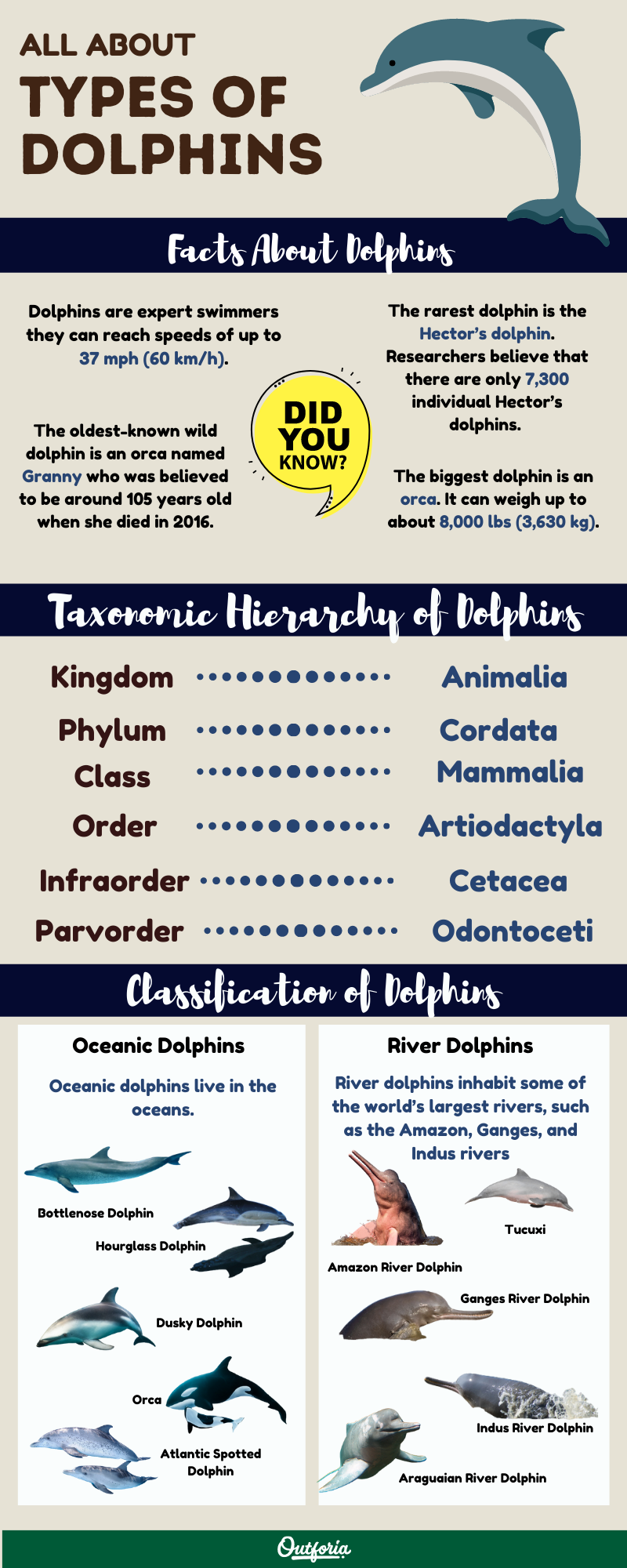
Share this Image On Your Site
<a href="https://outforia.com/types-of-dolphins/"><img style="width:100%;" src="https://outforia.com/wp-content/uploads/2021/10/Types-of-sea-turtles-infographics-1021.png"></a><br>Types of Dolphins Infographic by <a href="https://outforia.com">Outforia</a>Dolphins are a type of marine mammal. But, as is the case with most marine mammals, classifying dolphins is no easy task.
All dolphins are members of the kingdom Animalia, the phylum Chordata, and the class Mammalia. This means that dolphins are a type of mammal, not a type of fish.
Below the class Mammalia, all dolphins are part of the order Artiodactyla. Interestingly, this order is commonly referred to as the even-toed ungulates.
Now, you might say to yourself, “Wait a minute, an ungulate is a hoofed animal, like a deer, bison, or giraffe. How in the heck could a dolphin be an ungulate?”
If this thought occurred to you, you’re not alone. It can be odd to think of dolphins as ungulates because they don’t have well-defined toes. However, taxonomists and evolutionary biologists believe that dolphins and the other ungulates all evolved from a common ancestor. So, there you have it. Dolphins are more closely related to llamas than to types of sharks. Who knew?
Moving past that weird bit of taxonomic trivia, dolphins are also all classified within the infraorder Cetacea. More commonly known as the cetaceans, the members of this infraorder include all the animals that are informally known as dolphins, whales, and porpoises.
Here’s where it gets interesting.
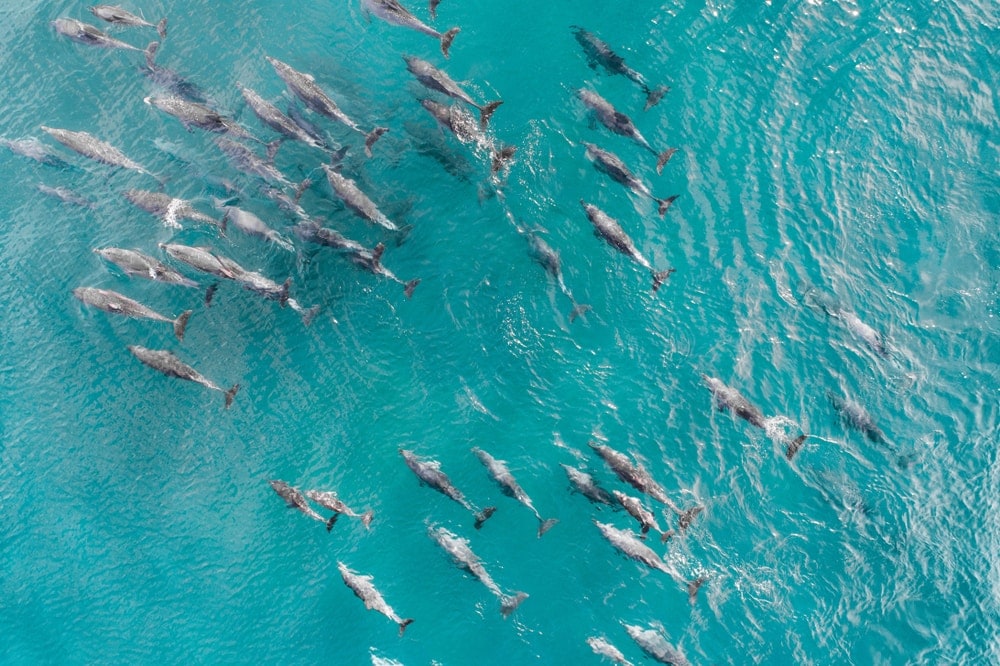
Technically, dolphins are whales. But, not all whales are dolphins. That’s because all dolphins are part of a parvorder known as Odontoceti, which includes the toothed whales.
The toothed whales encompass all the cetaceans that have teeth, including dolphins, porpoises, and whales like the beluga, narwhal, and sperm whale. All the non-toothed whales (called baleen whales) are in the parvorder Mysticeti.
From here, things get even more complicated.
Informally, most people separate the oceanic dolphins from the river dolphins. However, all of the oceanic dolphins are part of a single family, Delphinidae, which includes about 30 living species. Meanwhile, the river dolphins are classified into 3 families: Platanistidae, Iniidae, and Pontoporiidae.
Within the family Delphinidae (the oceanic dolphins), there’s quite a bit of debate over the classification of individual species. Traditionally, there were 6 subfamilies in the family Delphinidae, but a new classification system based on genetic analyses claims that there are only 5 families.
This taxonomic debate is why you might find different species names for a single type of oceanic dolphin.
For example, the Peale’s dolphin’s current species name is Sagmatias australis; however, it was traditionally called Lagenorhynchus australis. Researchers decided to add a new genus for the Peale’s, dusky, and Pacific white-sided dolphins called Sagmatias because of new information from these genetic analyses. But, not all scientists agree with this decision.
Ultimately, these taxonomic debates remind us that the classification of animals is a work in progress. As more information comes to light through scientific research in the future, scientists will be in a better position to more accurately classify the different types of dolphins.
You may also like: Meet The 21 Wonderful Types of Whales that Roam the Ocean: Guides, Classification, Images, and More!
Dolphin Fun Facts
Fancy yourself a cetologist? Here are some amazing dolphin fun facts that you ought to know.
1| Dolphins Like To Communicate Using Whistles
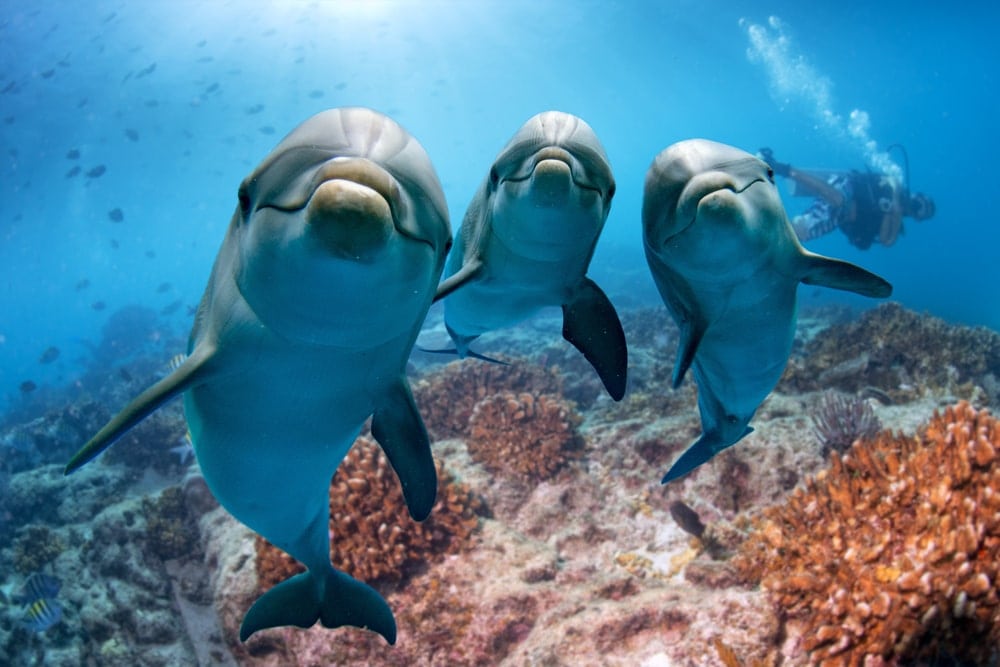
Dolphins are incredibly social animals. They communicate through an extensive and complex series of whistles that travel quickly through the water. In fact, sound can travel many times faster in the water than through the air, making it easier for dolphins to communicate across large distances.
Researchers believe that bottlenose dolphins, in particular, have a type of high-pitched whistle that they use to identify themselves in a group. Making this whistle sound can let the rest of the pod know who is with the group at any given time.
Additionally, dolphins in a pod or in a well-bonded pair are known to use whistles to find each other if they get separated. This sort of behavior is more common among calves and their mothers, but it also happens when an adult gets separated from the pod.
Bottlenose dolphins, among other species, can also copy another individual’s signature whistle. Doing so might be a way to get another dolphin’s attention, especially when traveling in a large pod.
That said, dolphins can make other sounds, too. During courtship, dolphins also make pulsating yelping noises. They can also create squeaks when they’re scared or stressed out.
2| Most Dolphins Hunt Through Echolocation
Dolphins, like other toothed whales, have a well-developed sense of echolocation. They’re able to echolocate as part of their hunting strategy, helping them to find food in deep, dark parts of the ocean.
When a dolphin hunts, it will create a series of clicks at different frequencies. The sound pulses associated with these clicks are then emitted through their foreheads, which are decidedly melon-shaped. Eventually, these clicks will bounce off of objects, like fish, and return to the dolphin via their lower jaw.
A dolphin can use the information that it receives from the sound pulses that return to its jaw to determine where its prey is. Although most dolphins have a great sense of sight, their ability to echolocate is what makes them excellent hunters. Who knew?
3| Dolphins Have Been Used for Warfare
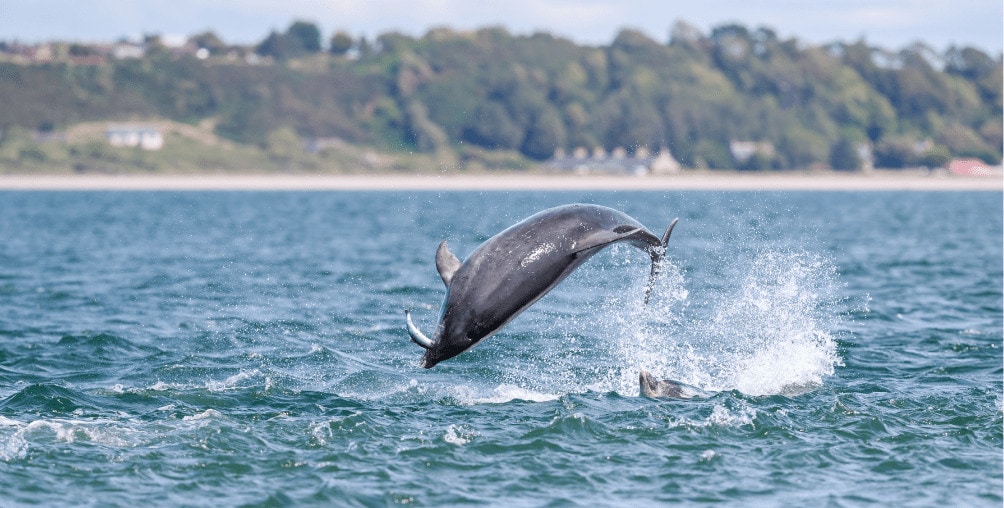
Yep, that’s right: dolphins have a long history of being used in warfare. In fact, the US Navy Marine Mammal Program is a long-standing program that’s trained countless marine mammals to aid in national defense since 1959.
When the program started, the US Navy and Marine Corps trained dozens of different marine mammal species, as well as sea turtles, seabirds, sharks, and rays. However, the program now trains only the California sea lion and the bottlenose dolphin.
Dolphins, in particular, are trained by the program to identify mines and other dangerous objects on the seafloor that would otherwise be difficult to detect with electric sonar. The dolphins in the program are generally trained to find and mark the location of any dangerous mines so that the military can remove them.
Additionally, dolphins have also been used to detect and apprehend unauthorized swimmers that might try to approach or harm military personnel or equipment. This program has also produced more than 1,200 scientific research publications that have helped advance human knowledge and understanding of these incredible animals.
4| Some Dolphins Are Incredibly Fast

It comes as no surprise that dolphins are expert swimmers. But did you know that they can reach speeds of up to 37 mph (60 km/h)?
In fact, dolphins are the fastest marine mammals on the planet. They’re so fast that they’re often seen riding on the waves coming off of the bow of ships and boats (this is called bow-riding).
Not all dolphins are super-fast, of course, but the common dolphin is arguably the speediest. Despite its large size, the orca can also reach speeds of up to 35 mph (56 km/h), too, making it a truly fierce hunter that’s hard to out-swim in the water.
5| A Dolphin Can Live For Decades
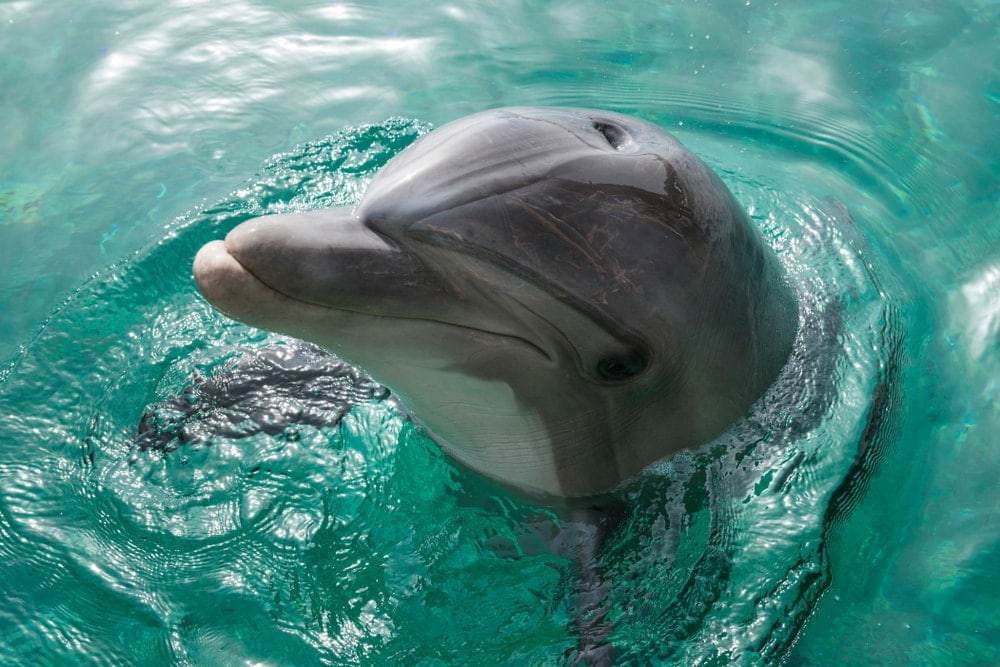
Most dolphin species aren’t well-studied due to the remoteness of their habitats. However, researchers do know that dolphins can live incredibly long lives.
In fact, the oldest-known wild dolphin is an orca named Granny who was believed to be around 105 years old when she died in 2016. She was first identified through a photo in the 1970s and she had been identified countless times in photos before her death.
Meanwhile, a bottlenose dolphin named Nicklo was believed to be about 67 years old when she died in 2017. Researchers in Sarasota Bay, Florida had known Nicklo since birth and she was a common sight in the area throughout her life.
That said, not much research has been done on dolphin lifespans and most of what we know is from photo evidence over the course of a cetacean’s lifespan. Most toothed whales appear to live shorter lives in captivity, too, making it even harder to understand the average lifespan of any given dolphin species.
You May Also Like: Different Types of Seals: Facts, Photos and More!
Types of Dolphins FAQs
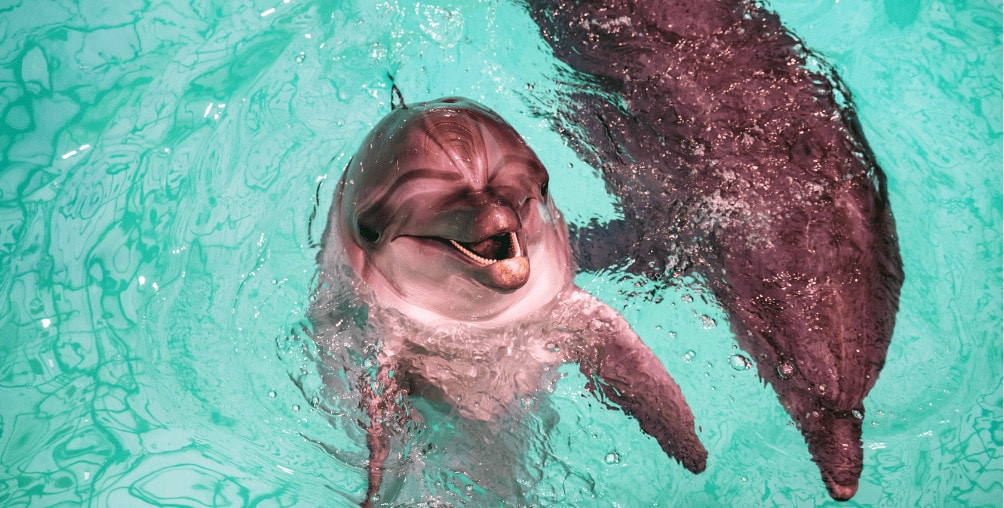
Here are our answers to some of your most commonly asked questions about the different types of dolphins:
What is the most common type of dolphin?
The most common type of dolphin is the long-beaked common dolphin (more frequently known just as the common dolphin) is the most abundant dolphin on the planet. Researchers believe that there are potentially as many as 6 million common dolphins in the wild.
What is the biggest dolphin?
The biggest dolphin is easily the orca. Although it’s commonly referred to as a whale, the orca is technically classified with the other dolphins. It is substantially larger than any other dolphin species, and it can weigh up to about 8,000 lbs (3,630 kg).
What is the rarest dolphin?
The rarest dolphin is the Hector’s dolphin, which lives solely around the coastal waters of New Zealand. Researchers believe that there are only 7,300 individual Hector’s dolphins. Additionally, a subspecies of the Hector’s dolphin, the Māui dolphin, has only 50 individuals remaining in the wild.
What is a group of dolphins called?
A group of dolphins is known as a pod. This is the same group noun that’s used to describe collections of other cetaceans, like whales and porpoises.
How many types of dolphins are there?
There are between 42 and 50 types of dolphins, depending on how different subspecies and populations are classified. The vast majority of these species are oceanic dolphins and only a minority live primarily in freshwater rivers.
You May Also Like: Beautiful Shell Types You Can Find On Beaches
The 25 Types of Dolphins Breeds
1. Oceanic Dolphins
The easiest way to categorize all of the world’s dolphins is by whether they live in oceans or in rivers. Although there are some dolphin species that sometimes blur the boundaries between oceans and rivers, most live their entire lives within one of these two types of water bodies. Here’s what you need to know.
As the name suggests, oceanic dolphins live primarily in oceans. The vast majority of the dolphin species on our planet are ocean dolphins, however, not all of these species are well-known to researchers. Let’s take a look at 19 of the most incredible types of oceanic dolphins on our planet.
1.1 Common Bottlenose Dolphin
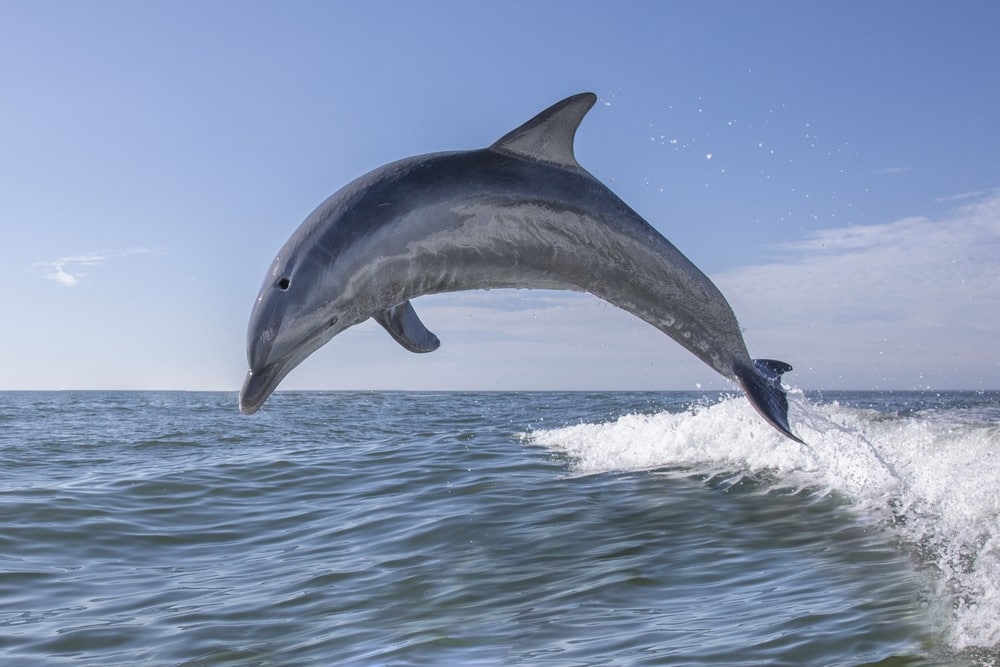
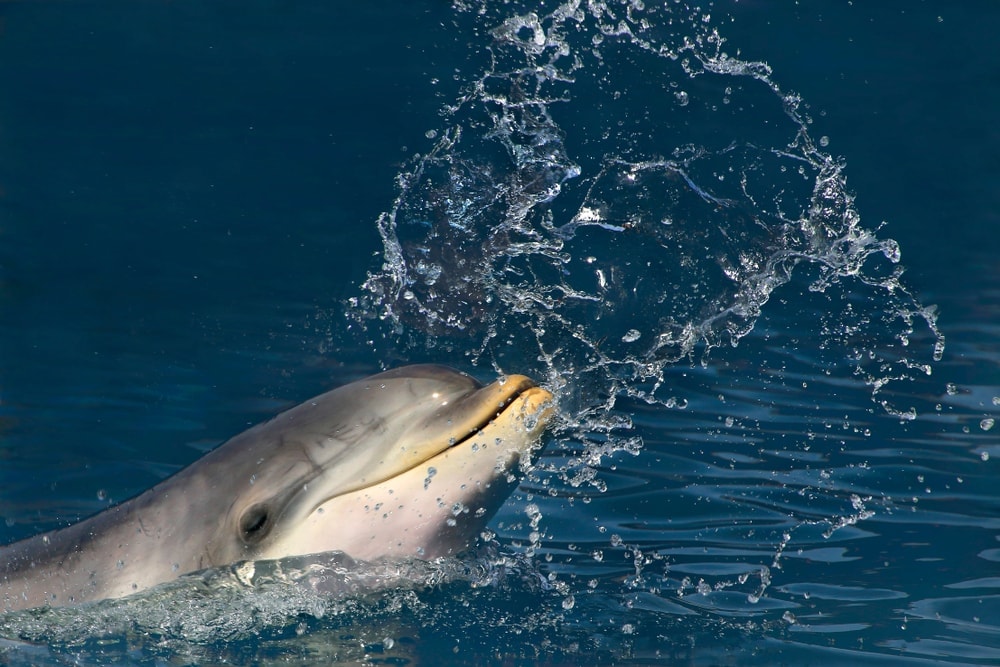
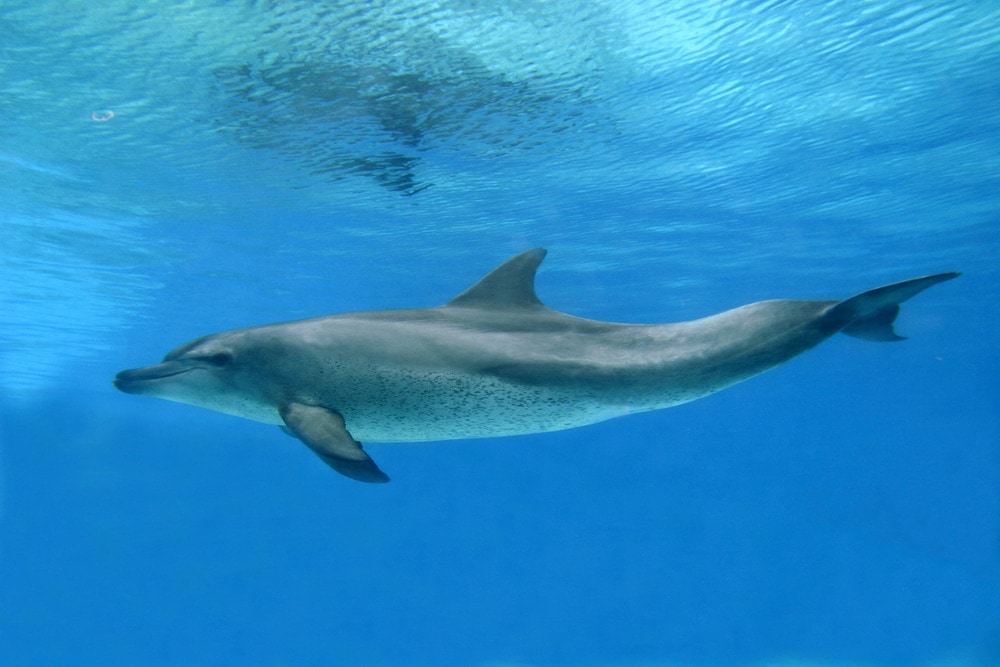
The common bottlenose dolphin (Tursiops truncatus) is easily the best-known dolphin species on the planet. It lives in nearly all of the world’s oceans except for the extreme northerly and southerly latitudes.
In the wild, the common bottlenose dolphin prefers to live in relatively warm and temperate seas. These animals enjoy eating shrimp, eels, squid, and a slew of different fish species. However, the species’ diet varies widely from location to location.
Although the common bottlenose dolphin is a widely distributed species, most humans know of it because it’s one of the most popular dolphins to keep in captivity at marine parks and aquariums. In the wild, however, the common bottlenose is listed as a species of least concern by the IUCN (International Union for Conservation of Nature).
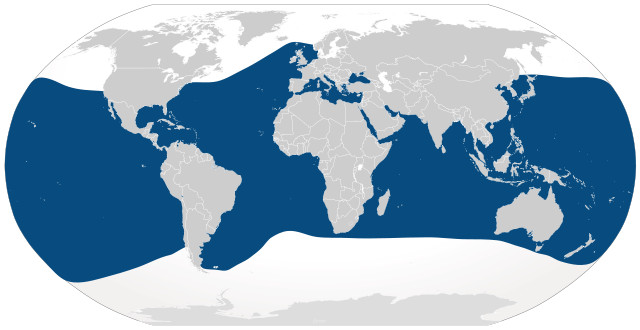
CC BY-S.A 3.0 / MAPLAP / wikimedia commons
1.2 Hourglass Dolphin
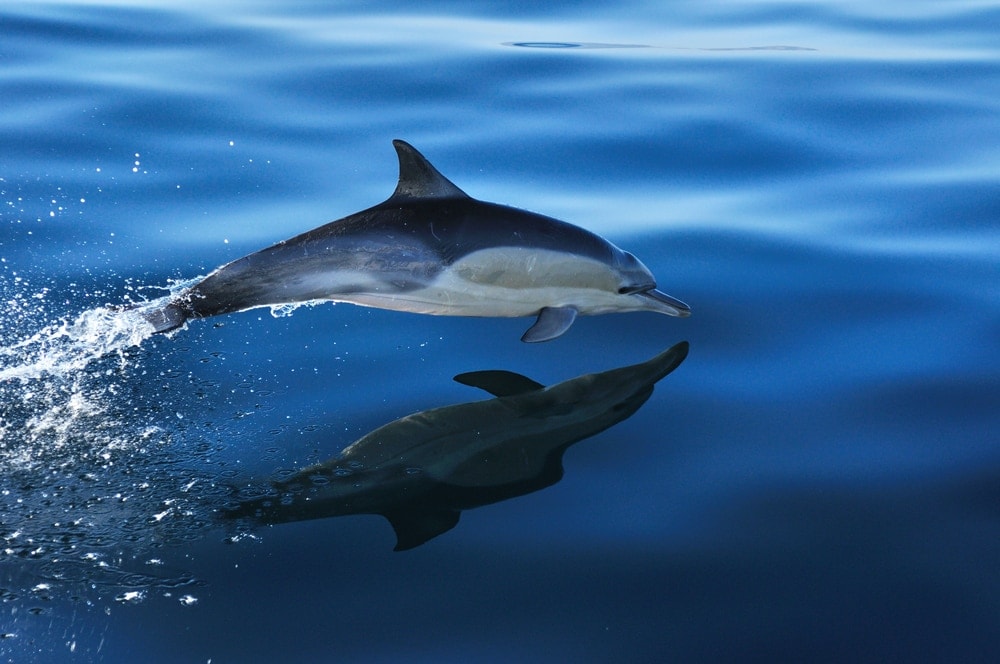

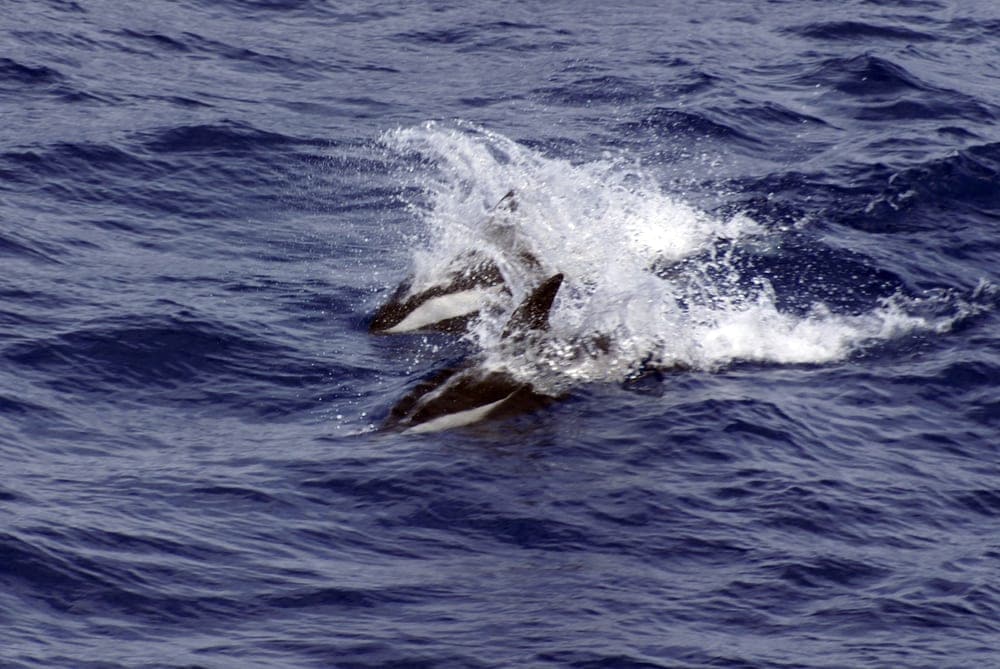
Although many dolphin species have wide distributions around the world, the aptly named hourglass dolphin (Sagmatias cruciger) is only found in Arctic and sub-Antarctic waters. It’s generally only seen by fishing vessels, research ships, and tourist boats as they cross the Drake Passage from Argentina and Chile to the Antarctic Peninsula.
The species is relatively easy to identify in its range because it has a distinctive black body with a white hourglass-like pattern. It could potentially be confused with the southern right whale dolphin, but the hourglass dolphin has a well-defined dorsal fin.
Not much is known about the hourglass dolphin due to the remote nature of its habitat. It’s listed as a species of least concern but there haven’t been enough studies to know if the species’ population is currently increasing or decreasing.
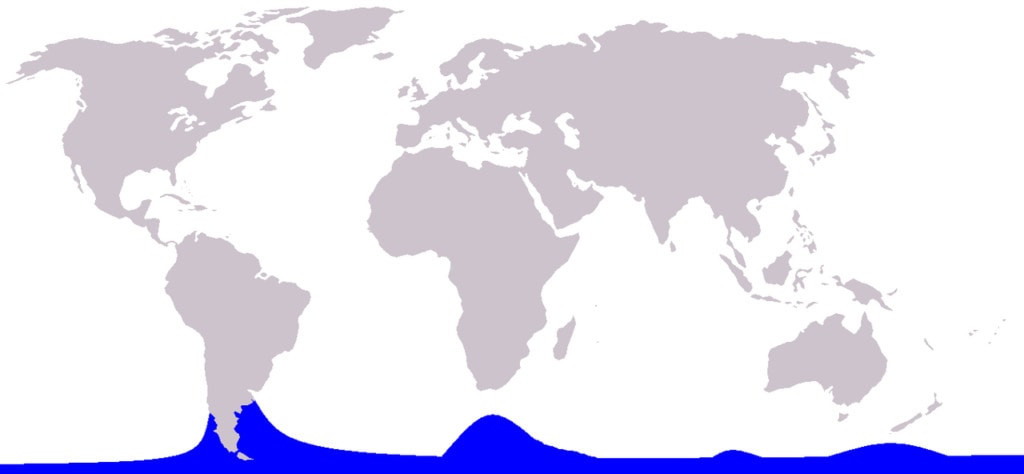
CC BY-S.A 3.0 / pcb21 / wikimedia commons
1.3 Dusky Dolphin
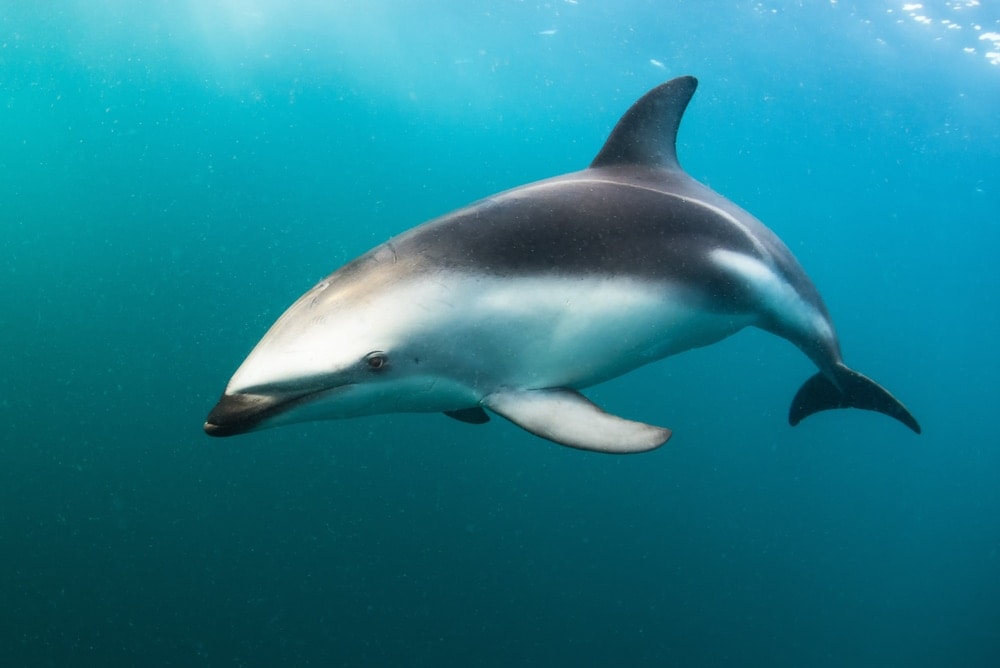
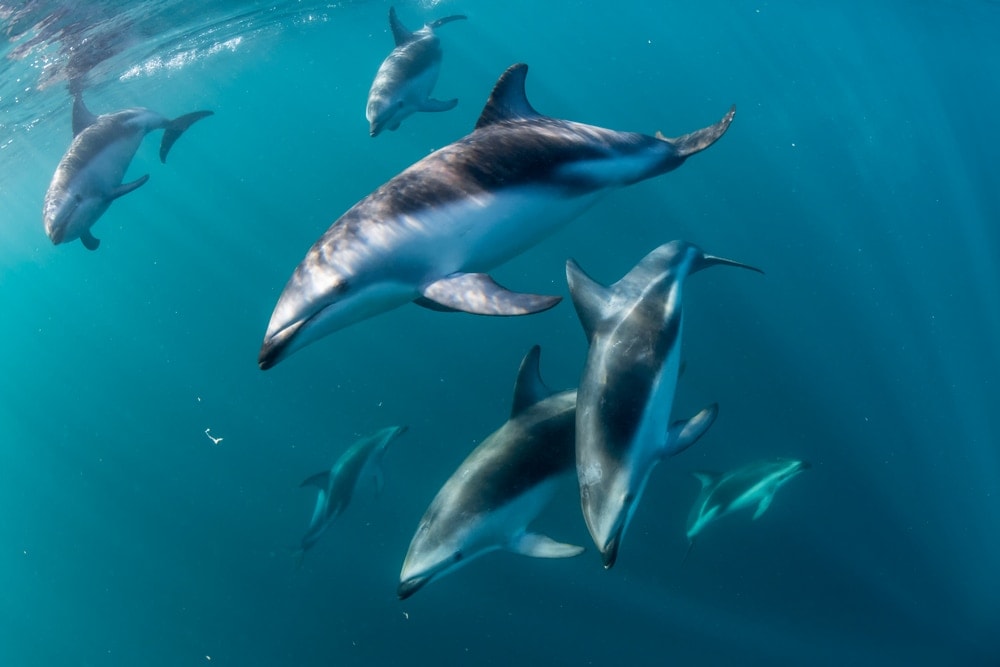
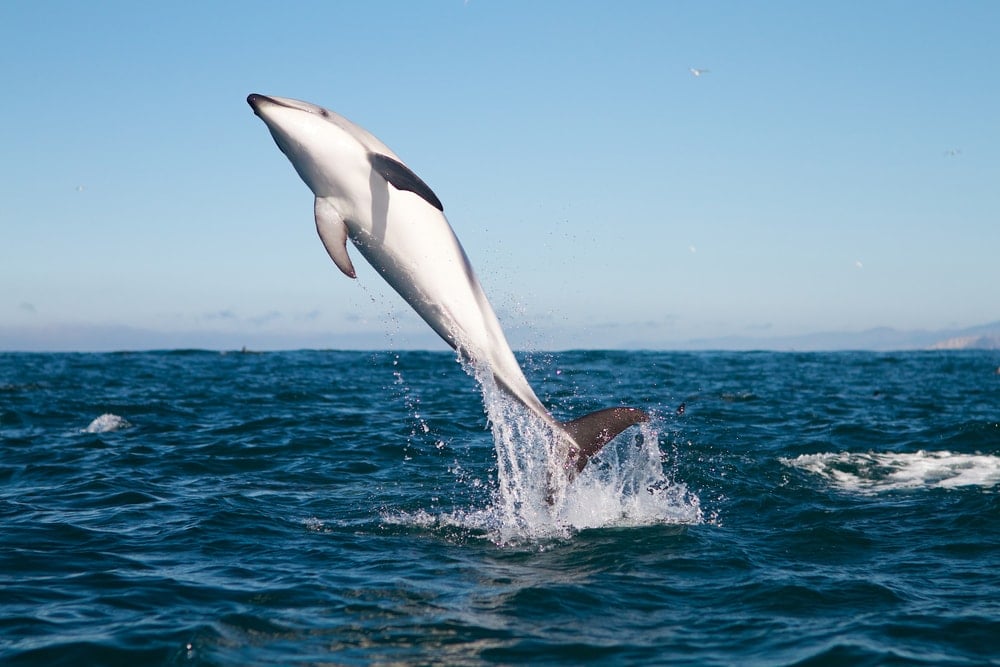
Best-known for its incredible aerial behaviors, the dusky dolphin (Sagmatias obscurus) is a mid-size cetacean that lives primarily in coastal waters around South America, southern Africa, Australia, and New Zealand.
The dusky dolphin’s coloration generally resembles that of the Pacific white-sided dolphin with its black back and white underside. However, the white patches on the dusky dolphin have larger concentrations of grey. It also generally has a longer, narrower rostrum (beak) than other dolphins in its range.
Of all the dolphin species, the dusky dolphin is one of the most popular among sailors. That’s because the species is known for traveling in groups and for doing impressive aerial behaviors, including jumps and spins. These dolphins are also known to mingle with other species, so you can often see a dusky dolphin mixed in with a group of Risso’s dolphins.
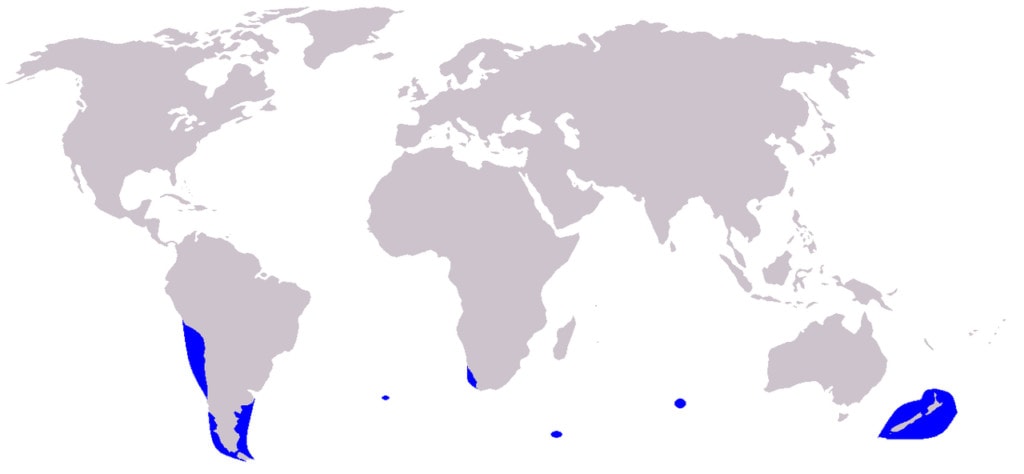
CC BY-S.A 3.0 / pcb21 / wikimedia commons
1.4 Orca
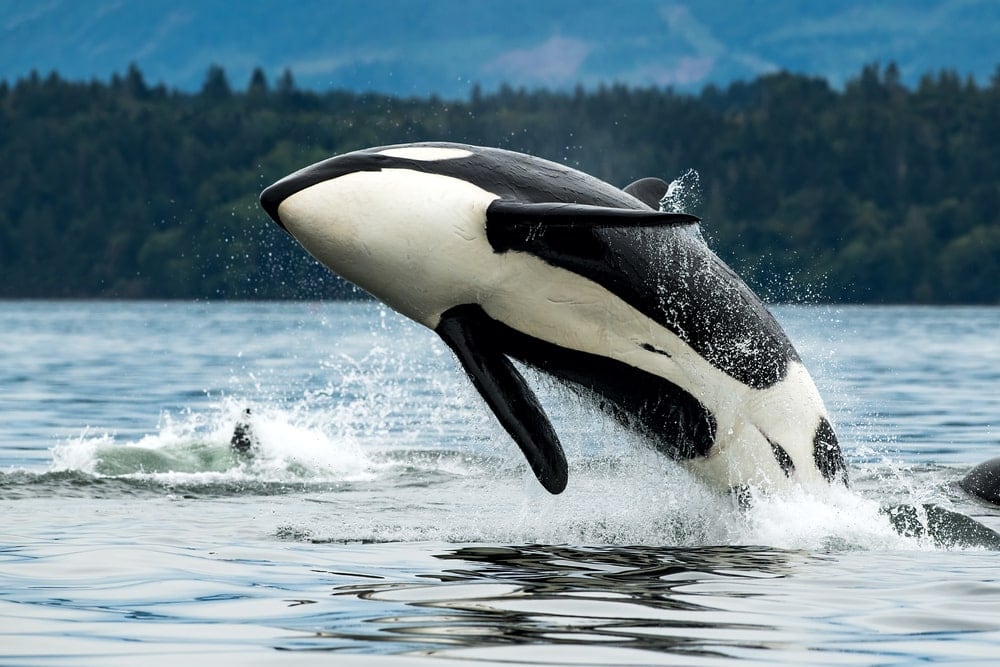
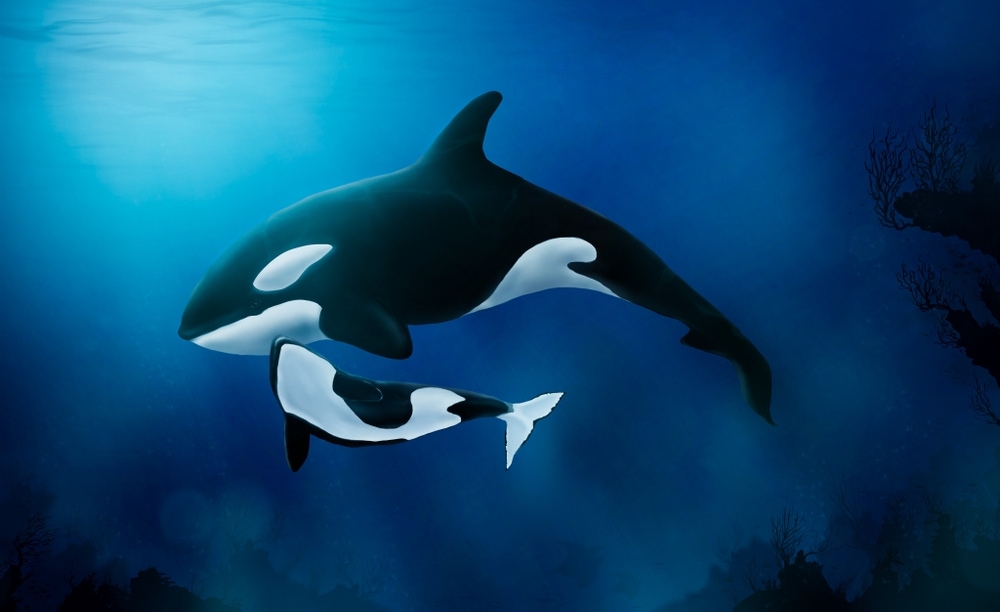
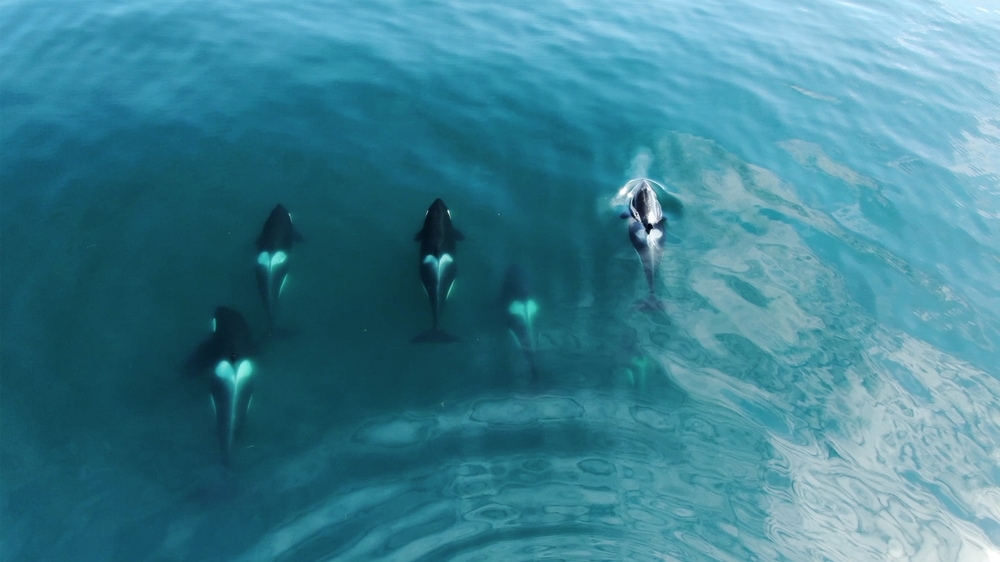
We know what you’re thinking: An orca isn’t a dolphin!
Well, it turns out that the orca (Orcinus orca), or ‘killer whale,’ is, indeed, a type of dolphin despite its large size. Technically, all dolphins are types of whales, but the orca is a type of toothed whale that belongs to the oceanic dolphin family (Delphinidae).
In fact, the orca is the largest of the dolphin species as they can grow to be upwards of 26 feet (8 m) in length and weigh around 7,000 lbs (3,175 kg). However, there’s quite a bit of variation in orca sizes because there are at least 4 known types of orcas that live in different parts of the Earth’s oceans.
Although the orca is one of the best-known dolphin species on the planet, it’s not actually very well researched. These elusive dolphins live in nearly all of the world’s oceans, including in the polar regions. But, there’s simply not enough information about their populations to know whether the species is at risk.
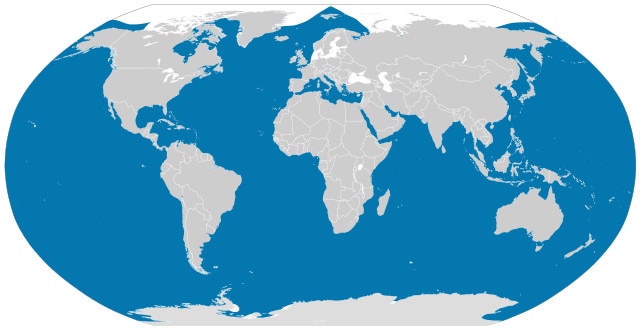
CC BY-S.A 3.0 / maplab / wikimedia commons
1.5 Hector’s Dolphin
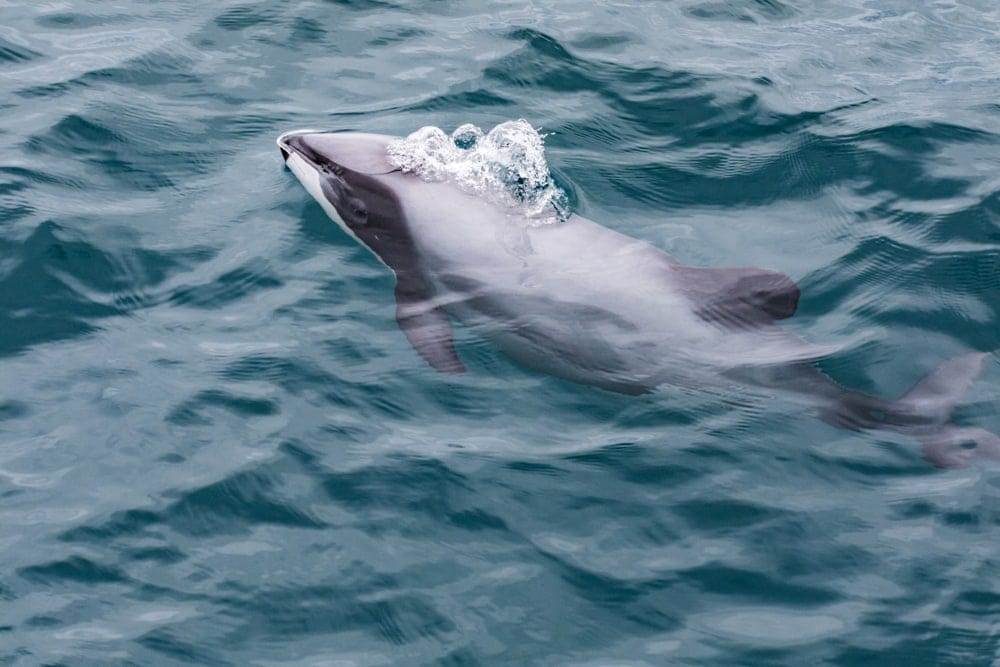
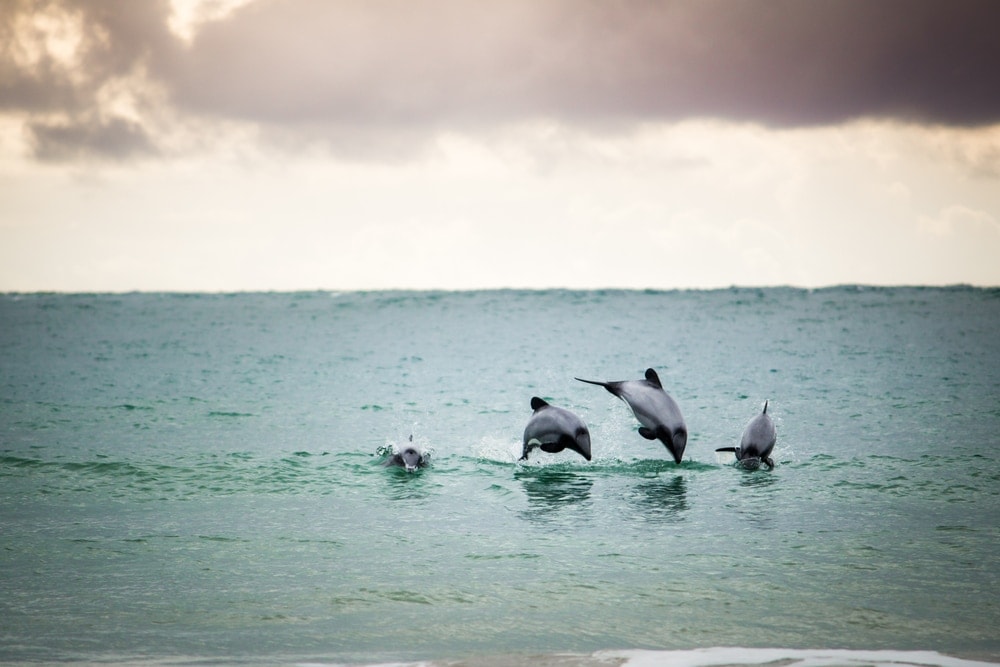
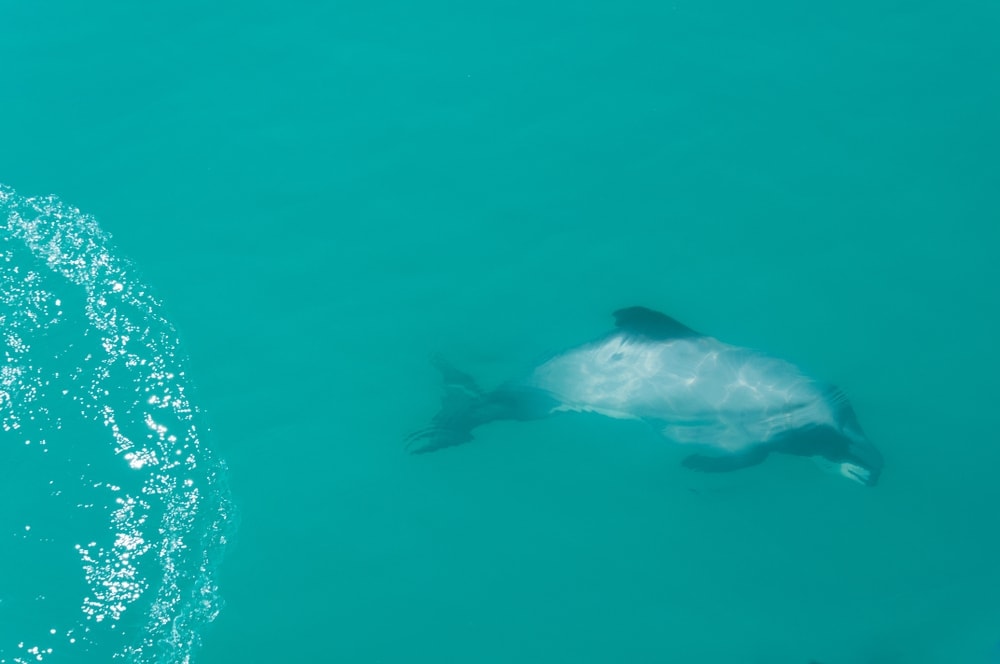
The Hector’s dolphin (Cephalorhynchus hectori) is both the smallest and rarest of the Earth’s oceanic dolphins. It lives exclusively in the coastal waters around New Zealand. There are two recognized subspecies of the Hector’s dolphin: the South Island Hectors and the Māui dolphin, the latter of which lives along the western coast of the North Island.
These cetaceans can grow to be around 5 feet (152 cm) in length and about 130 lbs (60 kg) in weight, so they’re very small by dolphin standards. They have no discernible beak, however, they have a distinctive rounded dorsal fin and a pale grey complexion.
Hector’s dolphins generally live in small groups for most of their lives. Their major threats include accidental bycatch in fishing nets and infectious diseases. The IUCN currently lists the species as endangered with a declining population of around 7,300 individuals.
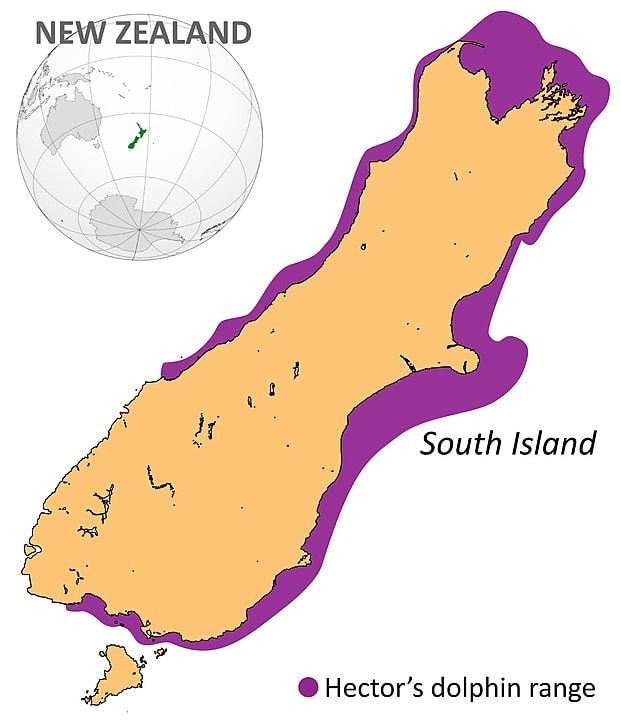
PUBLIC DOMAIN / RUDOLPH89 / wikimedia commons
1.6 Atlantic Spotted Dolphin
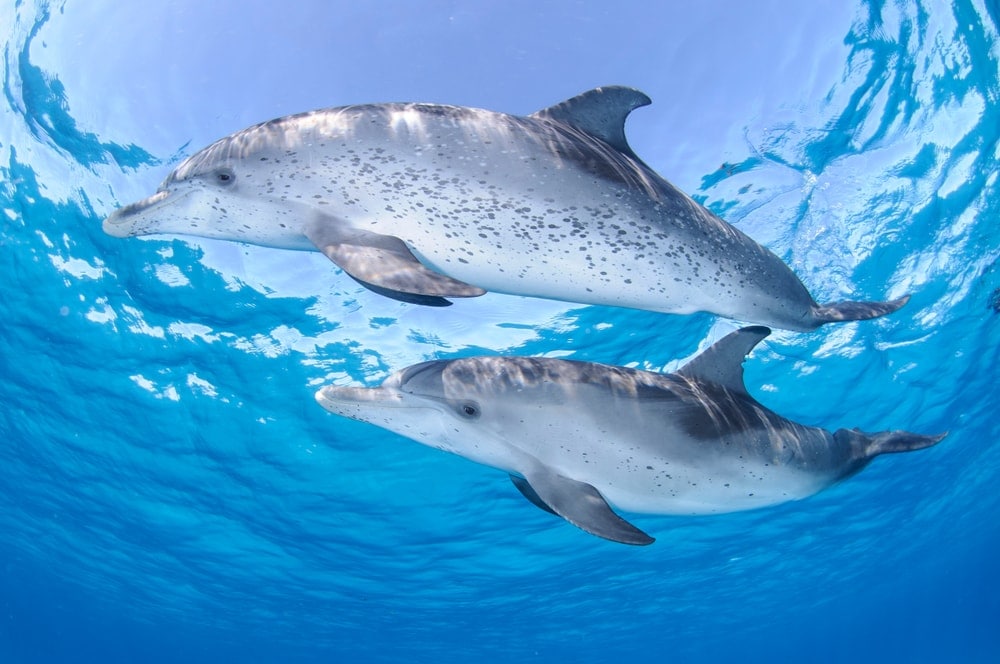
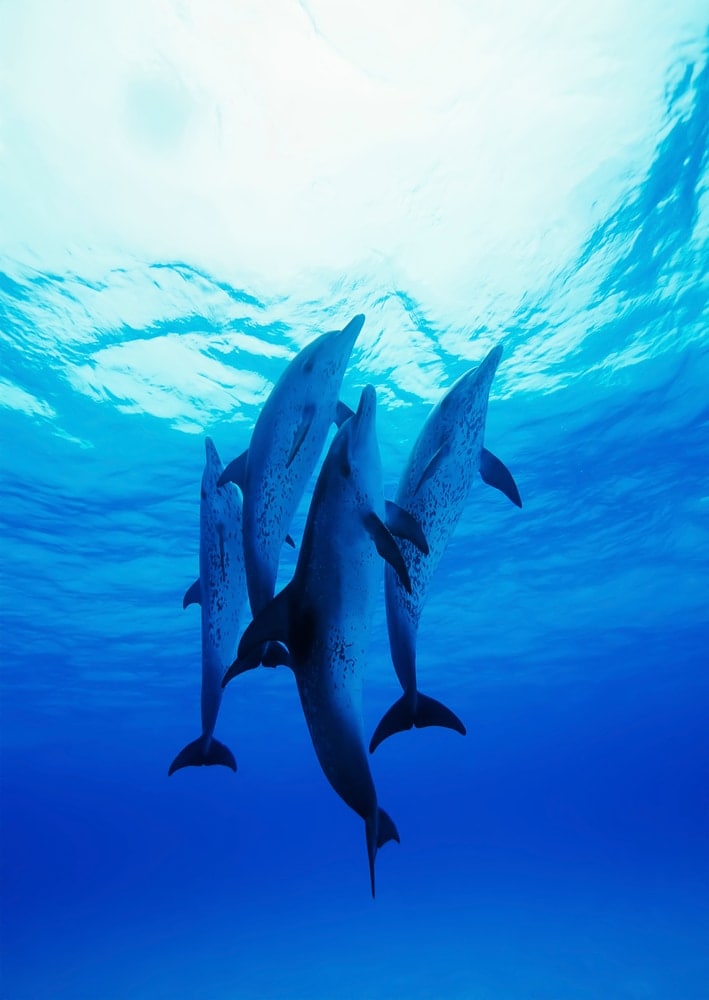
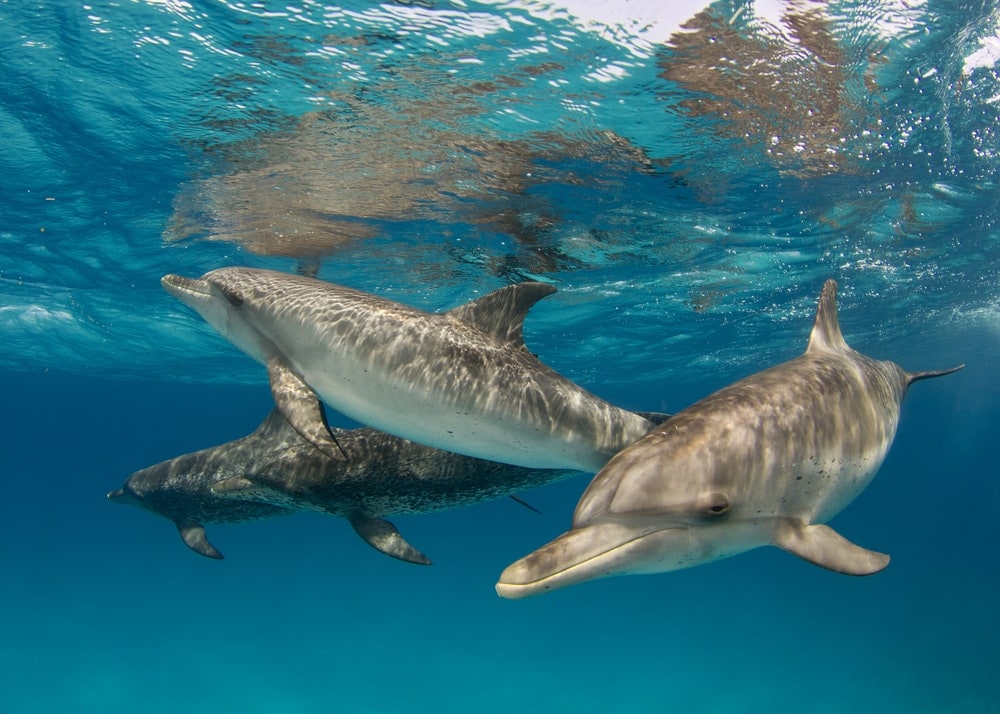
One of the most easily identifiable cetaceans, the Atlantic spotted dolphin (Stenella frontalis) is a relatively large dolphin that lives in the tropical and temperate Atlantic Ocean. It’s commonly spotted around the Bahamas and in the Gulf of Mexico, but you can find it as far north as Cape Cod.
Interestingly, the Atlantic spotted dolphin isn’t born with its characteristic spots. Rather, these dolphins are generally born with a greyish-white coloration that changes over time to include mottled grey and black spots. This transition normally happens before the age of 9, so a dolphin with more spots is usually an older individual.
The Atlantic spotted dolphin is listed as a species of least concern, however, there isn’t much information about the species’ recent population trends.
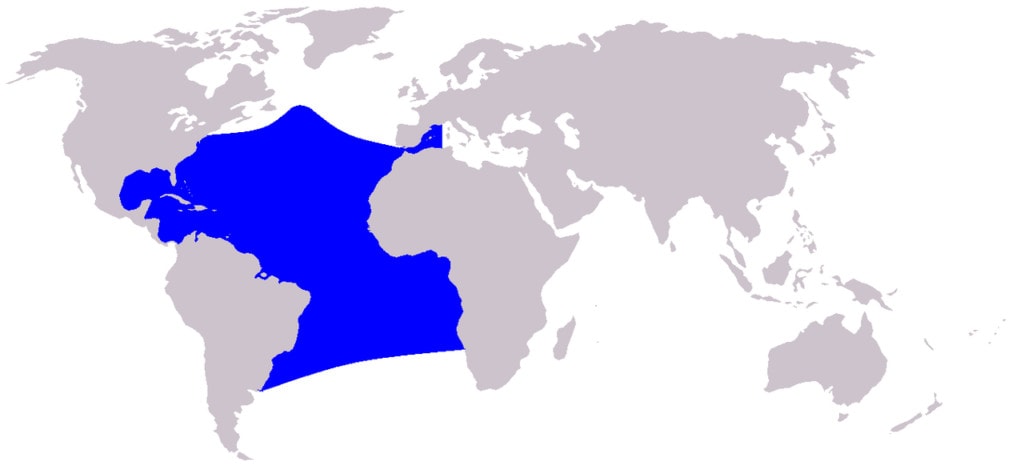
CC BY-S.A 3.0 / WIDEWITT / wikimedia commons
1.7 Commerson’s Dolphin
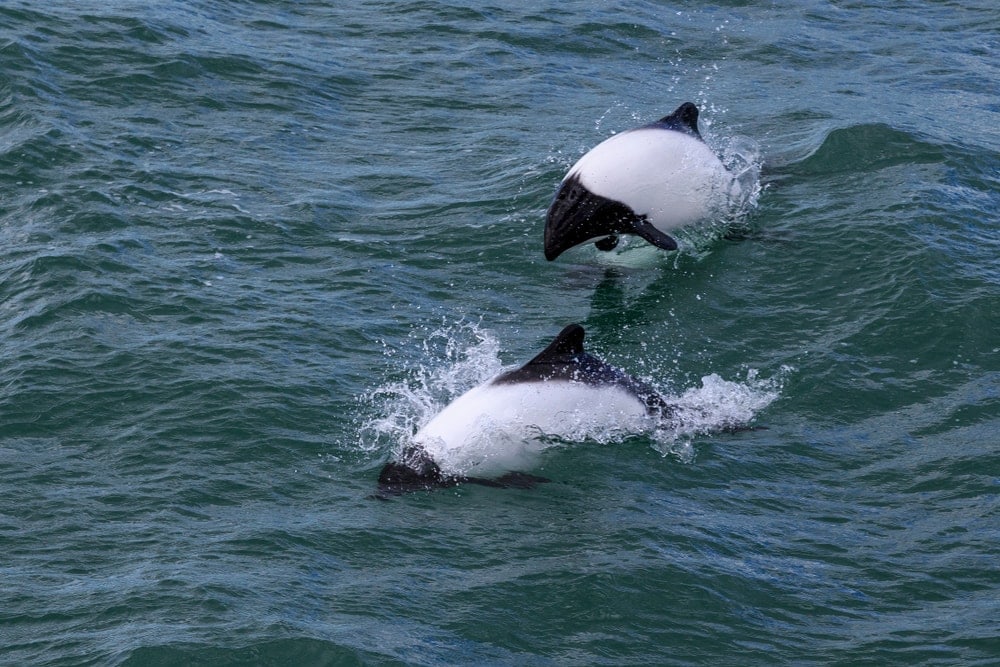
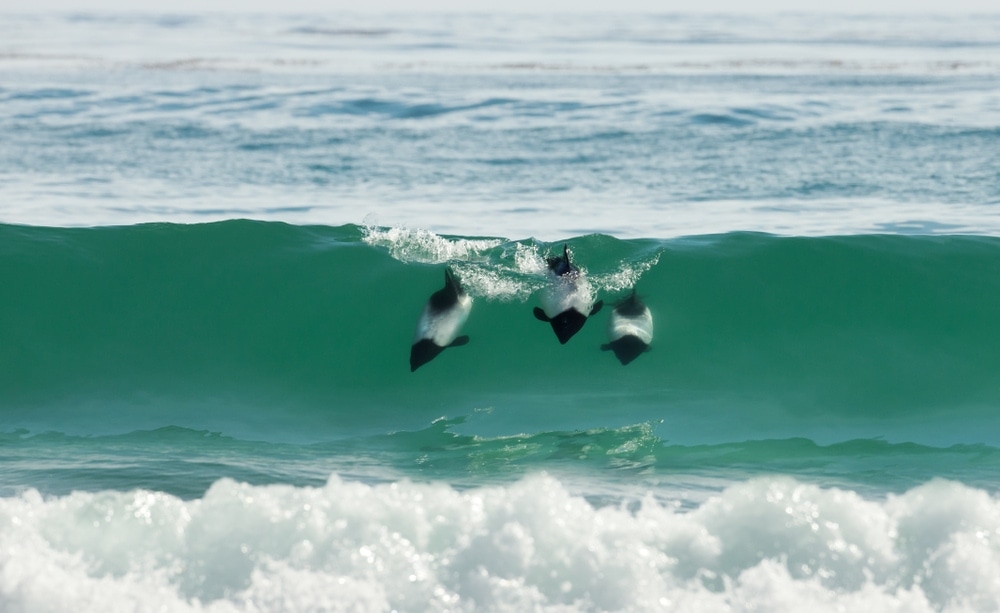
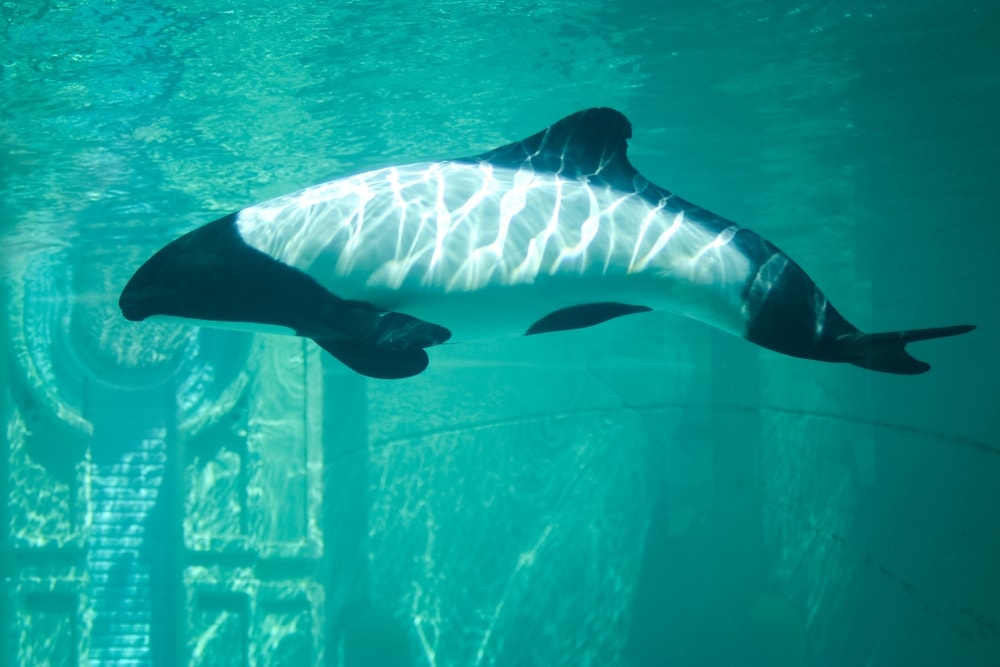
Also known as the jacobita or the panda dolphin, the Commerson’s dolphin (Cephalorhynchus commersonii) is a small cetacean that lives exclusively around southern South America and the Kerguelen Islands.
The species is most commonly spotted in the Beagle Channel around Tierra del Fuego and around the Falkland Islands (Islas Malvinas). They are generally easy to identify within their range due to the contrast between their distinctive black heads, dorsal fins, and tails and their all-white bodies.
Overall, the Commerson’s dolphin is listed as a species of least concern, however, it often gets caught in fishing nets close to the shoreline. In the past, Commerson’s were also hunted for use as crab bait, but this is no longer common practice.

public domain / jujutacular / wikimedia commons
1.8 Irrawaddy Dolphin
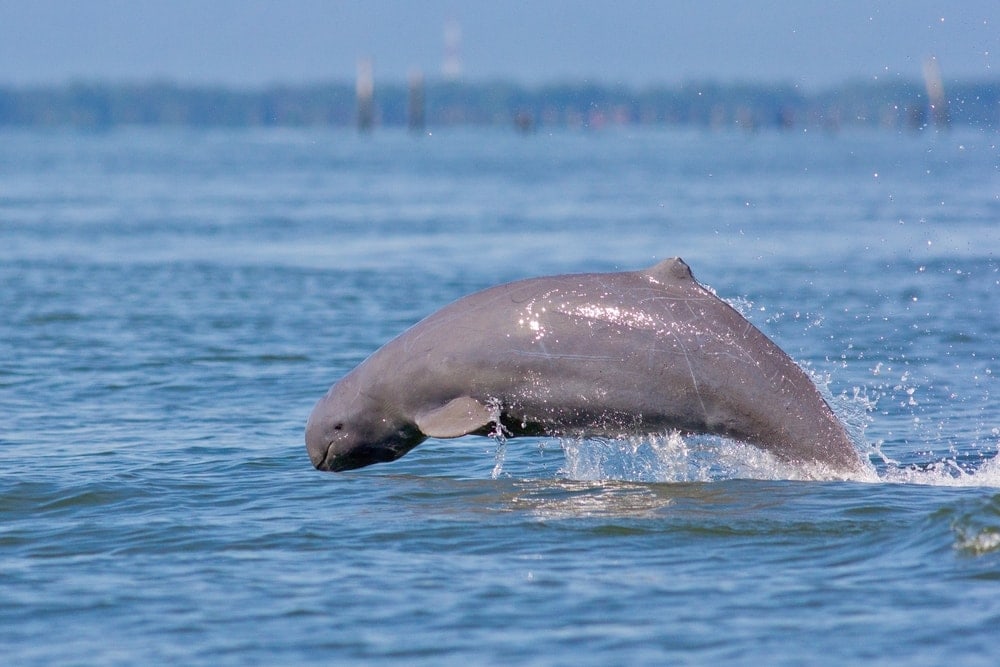
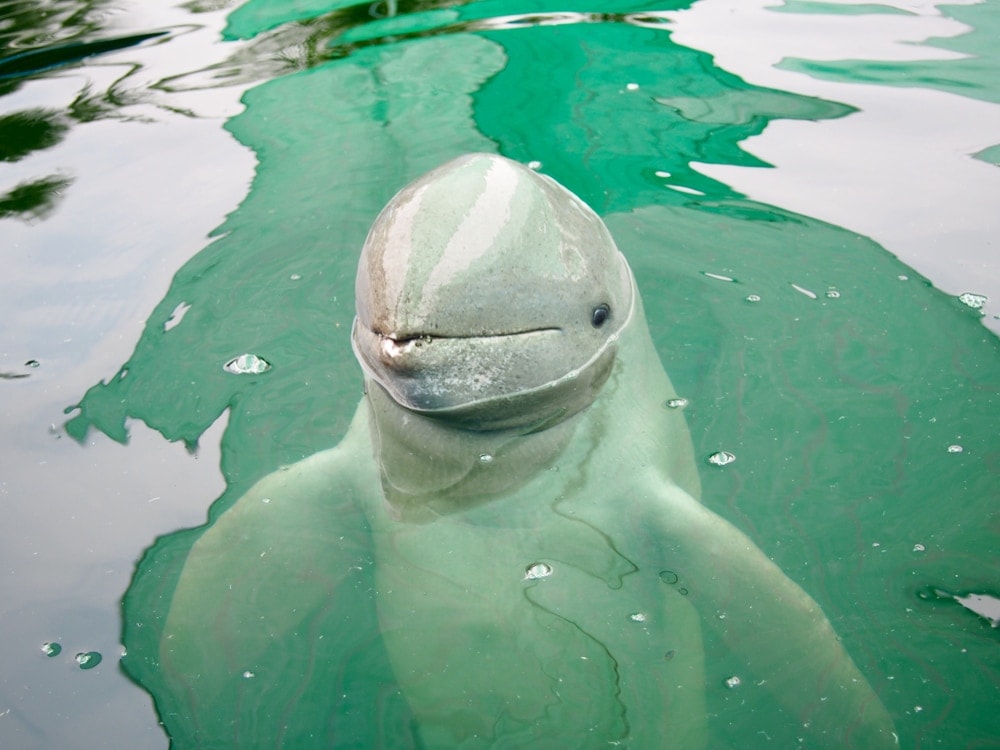
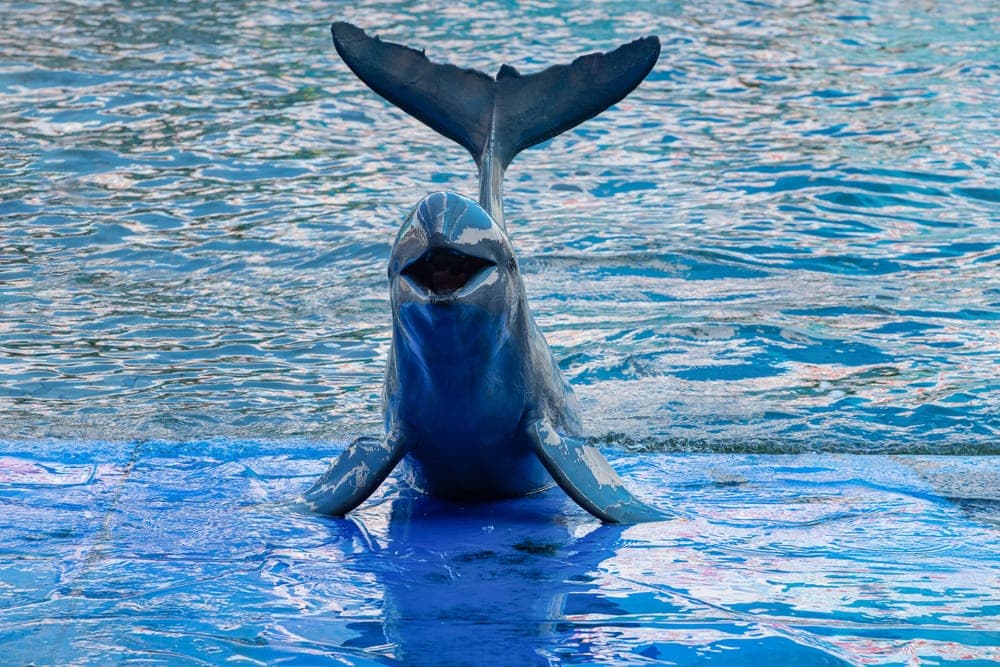
The Irrawaddy dolphin (Orcaella brevirostris) is a unique and fascinating oceanic cetacean that lives in multiple separate populations around coastal southeastern Asia. It was long considered to be a subspecies of the Australian snubfin dolphin, but it has been described as a separate species since 2005.
For the most part, the Irrawaddy dolphin has a light grey underside and a dark grey back. It has a rounded forehead in lieu of a beak, and it has a very small rounded dorsal fin. In many ways, the Irrawaddy dolphin looks like a beluga, but they’re impossible to confuse in the wild because they have vastly different ranges.
Most Irrawaddy dolphins are shy around boats and humans, but you can sometimes see them spy hopping when they get curious. The Irrawaddy is currently listed as endangered with a declining population due primarily to pollution and habitat disruption.
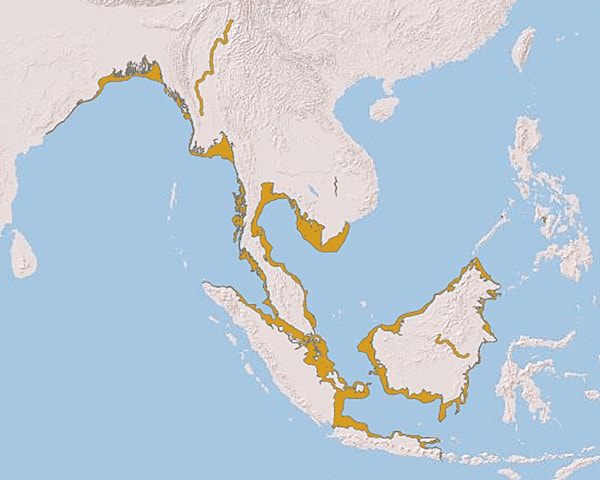
CC BY-S.A 4.0 / 蕭漫 / wikimedia commons
1.9 Spinner Dolphin
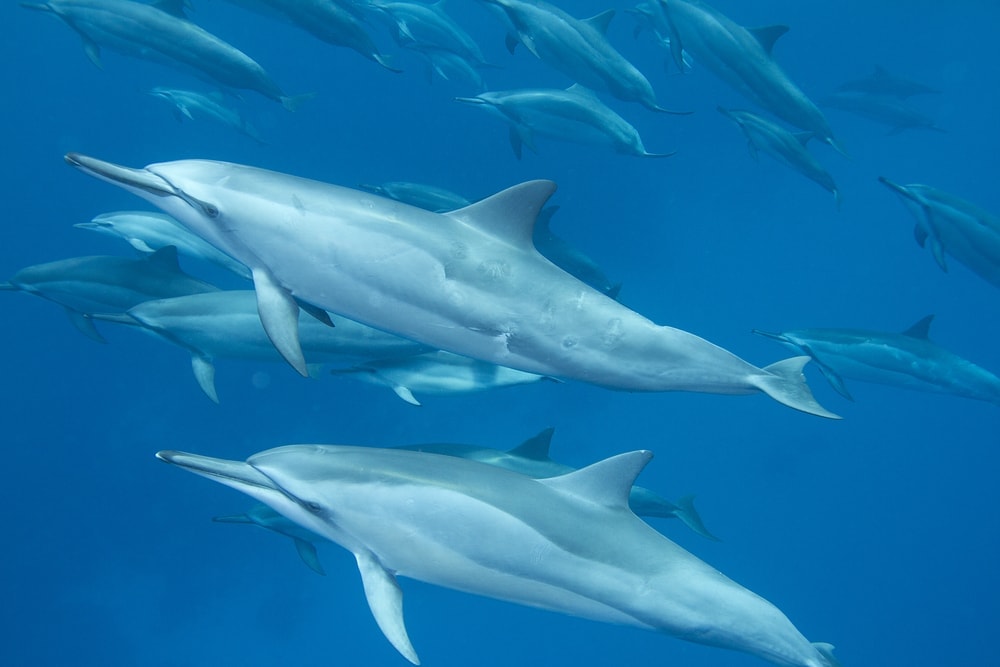
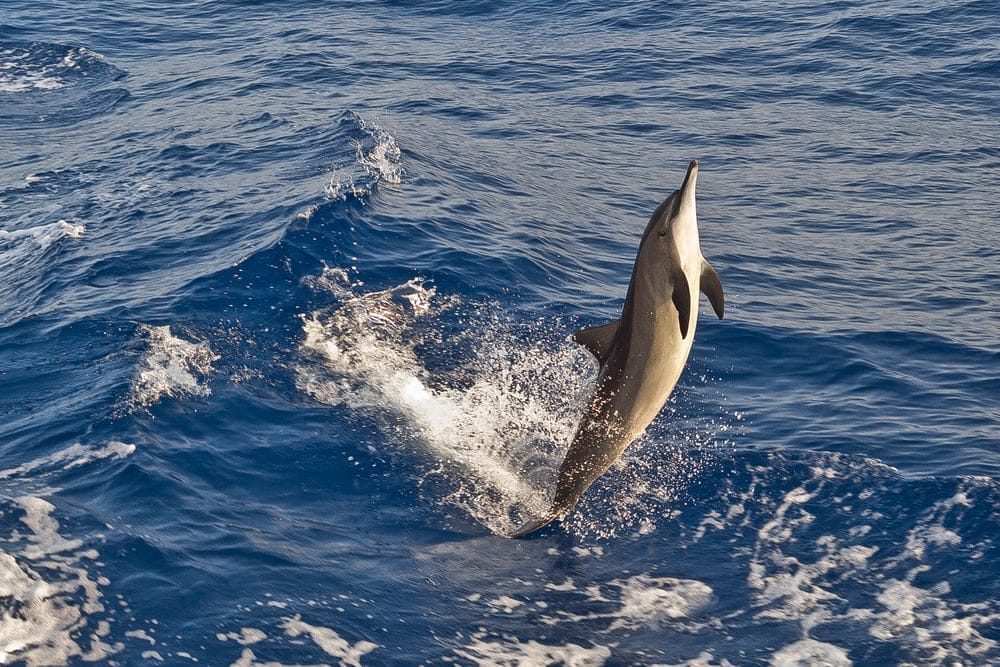
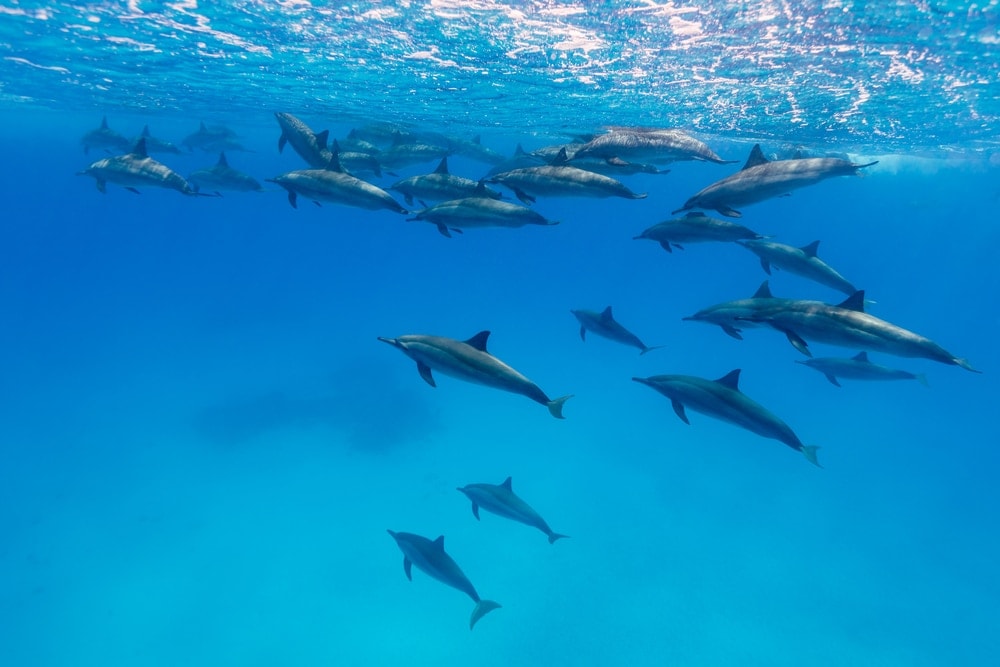
Found only in tropical and sub-tropical waters, the spinner dolphin (Stenella longirostris) is a small cetacean that’s particularly well-known for its acrobatic abilities. Also known as the long-snouted dolphin, the spinner dolphin has 4 recognized subspecies, most of which are differentiated by their geographic ranges.
The spinner dolphin prefers to feed on fish that live in the so-called twilight zone of the ocean. So, it will dive upward of 1,000 ft (300 m) to feed on fish. However, some subspecies of the spinner dolphin prefer to feed only at night and other subspecies feed as a group rather than individually.
Of all their unique traits, spinner dolphins are most famous for their ability to jump out of the water and spin around in mid-air. Researchers have found that the species is capable of spinning up to 10 times in a single jump, which is pretty darn impressive if you ask us.
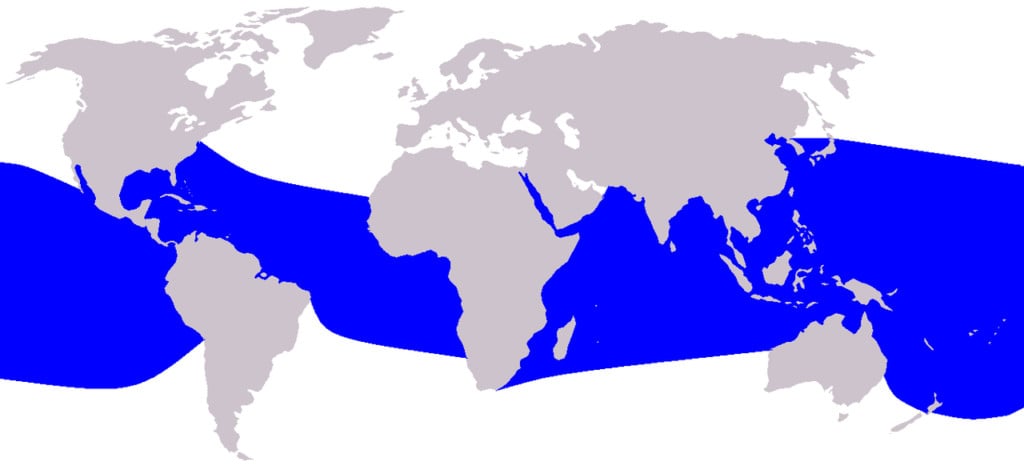
CC BY-S.A 3.0 / pcb21 / wikimedia commons
1.10 Long-Finned Pilot Whale
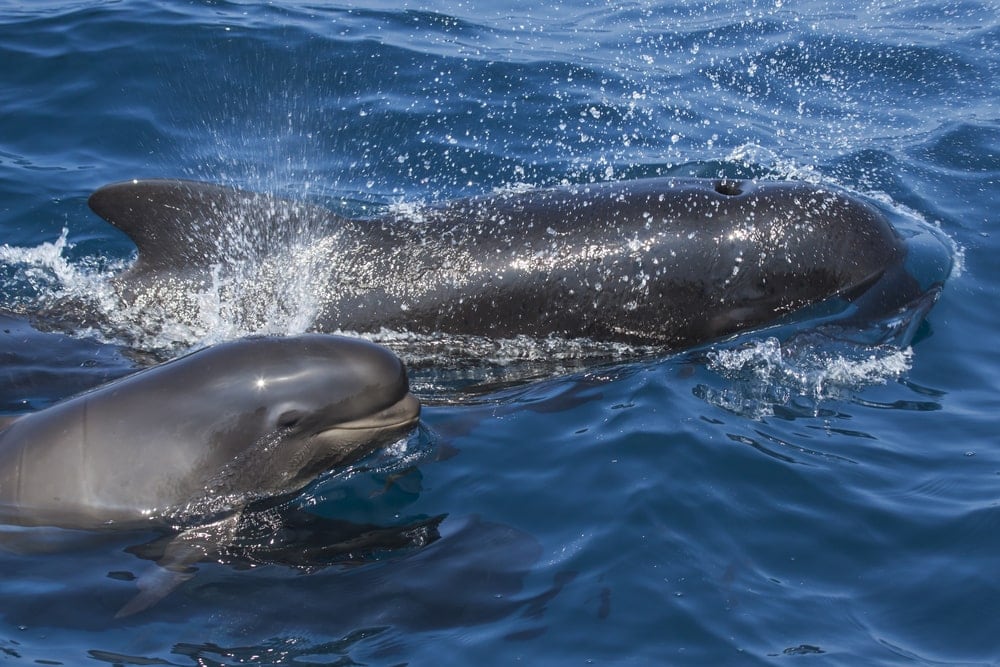
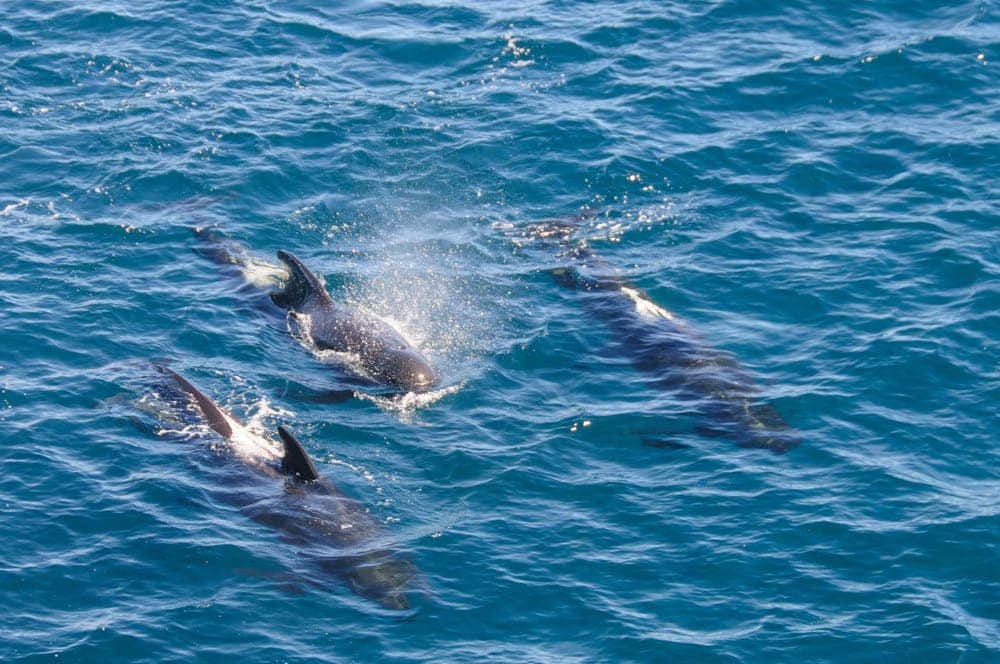
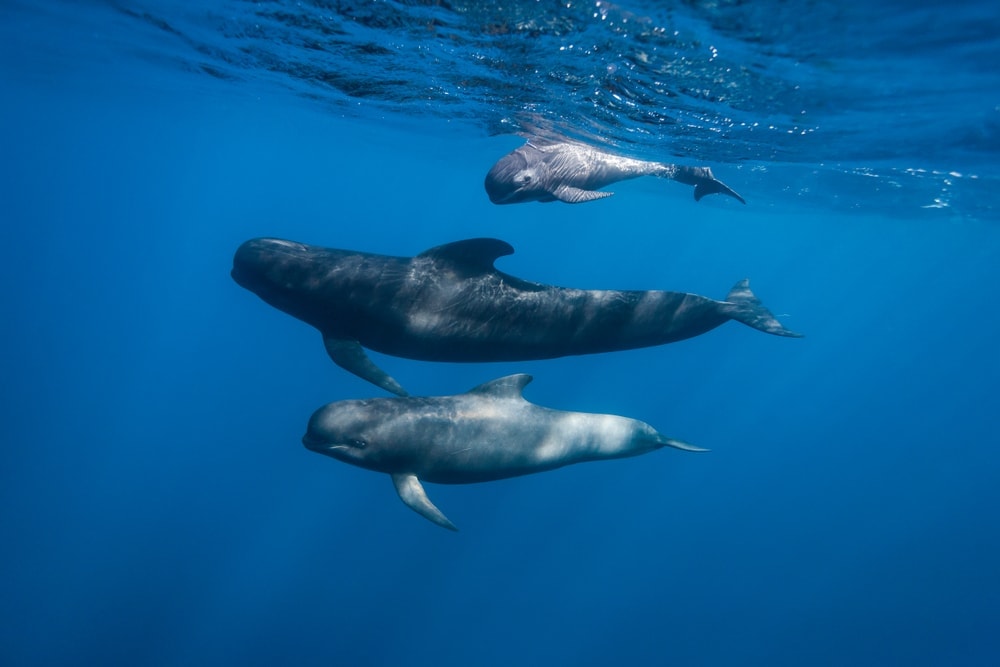
Like the orca, the long-finned pilot whale (Globicephala melas) is, indeed, a type of dolphin, even if it has the word ‘whale’ in its name. The long-finned pilot whale is almost indistinguishable visually from its close relative, the short-finned pilot whale, but they are two separate species with different ranges.
Long-finned pilot whales live primarily in the northern Atlantic Ocean, the southeastern Pacific Ocean, and the Southern Ocean. They have very rounded, melon-like heads that make them look a lot like belugas, but their dark coloration makes them difficult to misidentify.
The long-finned pilot whale is listed as a species of least concern by the IUCN. It is protected in many parts of its range, but it is one of the main targets of the annual grindadráp whale hunt in the Faroe Islands. The hunt is for subsistence, rather than commercial purposes, but it is highly controversial outside of the Faroe Islands.
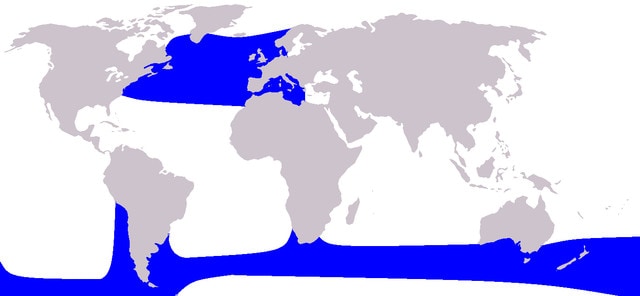
CC BY-S.A 3.0 / pcb21 / wikimedia commons
1.11 Peale’s Dolphin
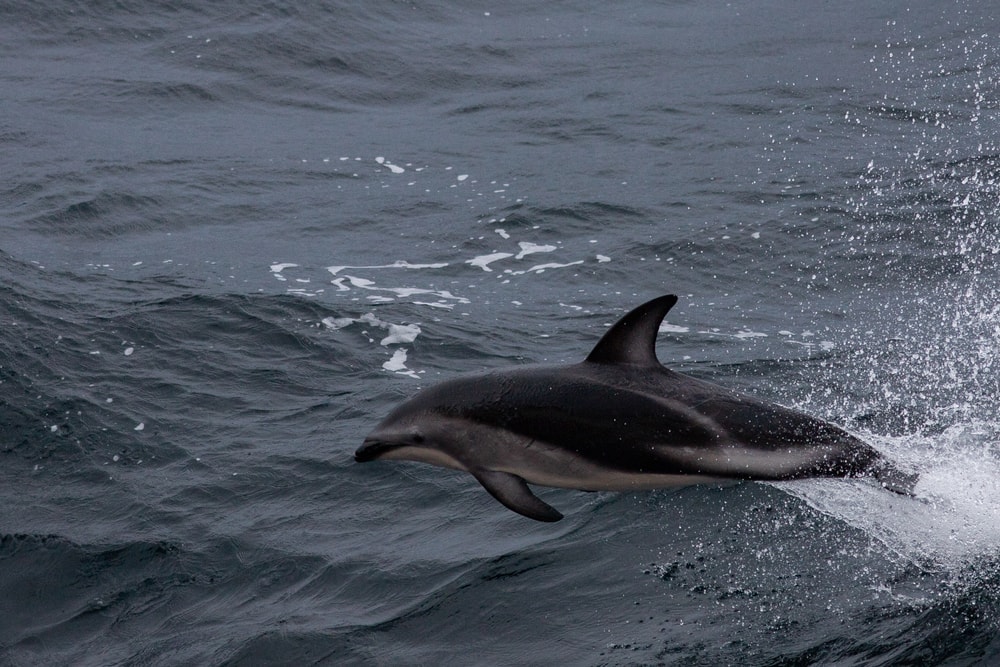
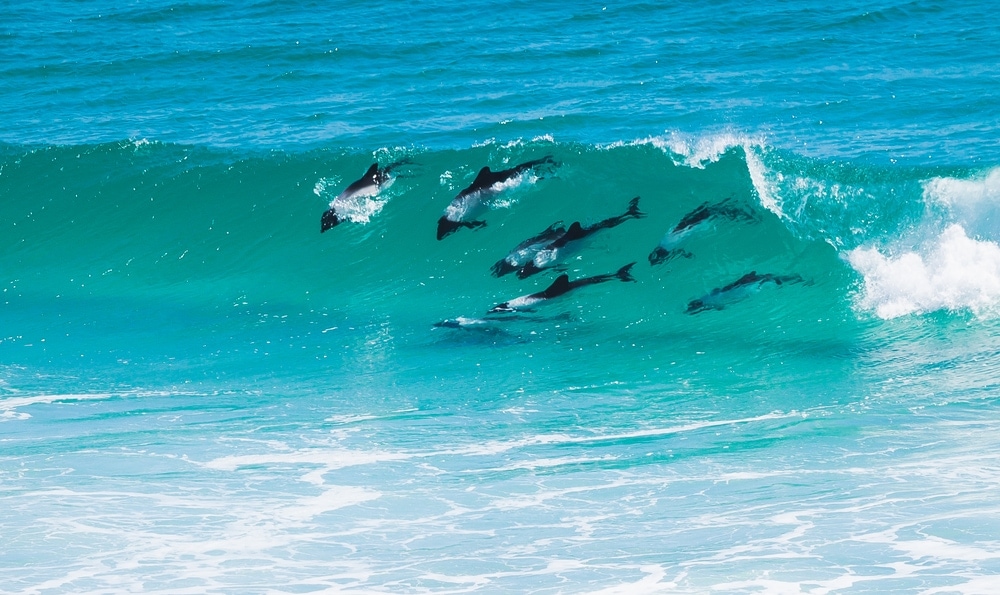
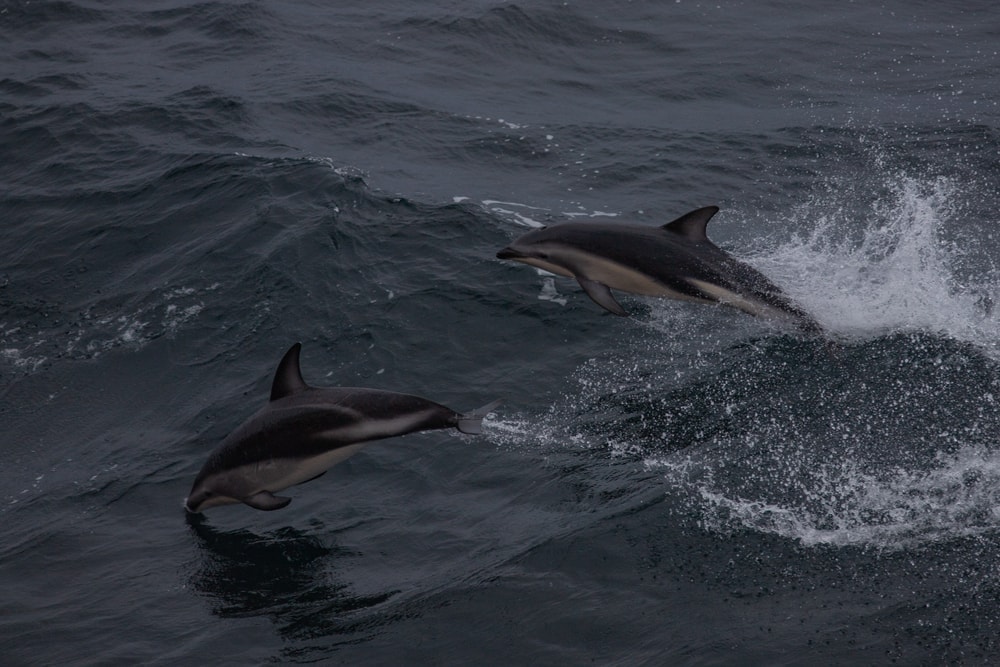
Also called the black-chinned dolphin, the Peale’s dolphin (Sagmatias australis) is a small cetacean that lives primarily around Tierra del Fuego in southern South America. It is often mistaken for dusky dolphins when viewed from a distance, but it has much larger patches of white on its belly.
The Peale’s dolphin prefers areas of fast-moving waters, so you can often see them near the entrance to bays and channels. They tend to congregate in small groups and they rarely travel far from shore.
Currently, the Peale’s dolphin is listed as a species of least concern, but more research is needed to truly understand its population trends. The dolphins often get trapped in fishing nets, but it’s not clear how much of a threat accidental bycatch actually poses to the species.
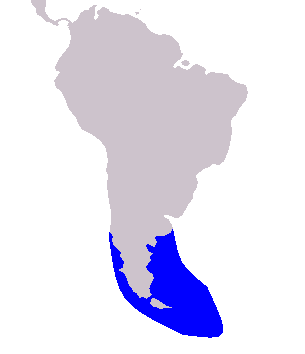
CC BY-S.A 3.0 / pcb21 / wikimedia commons
1.12 Clymene Dolphin
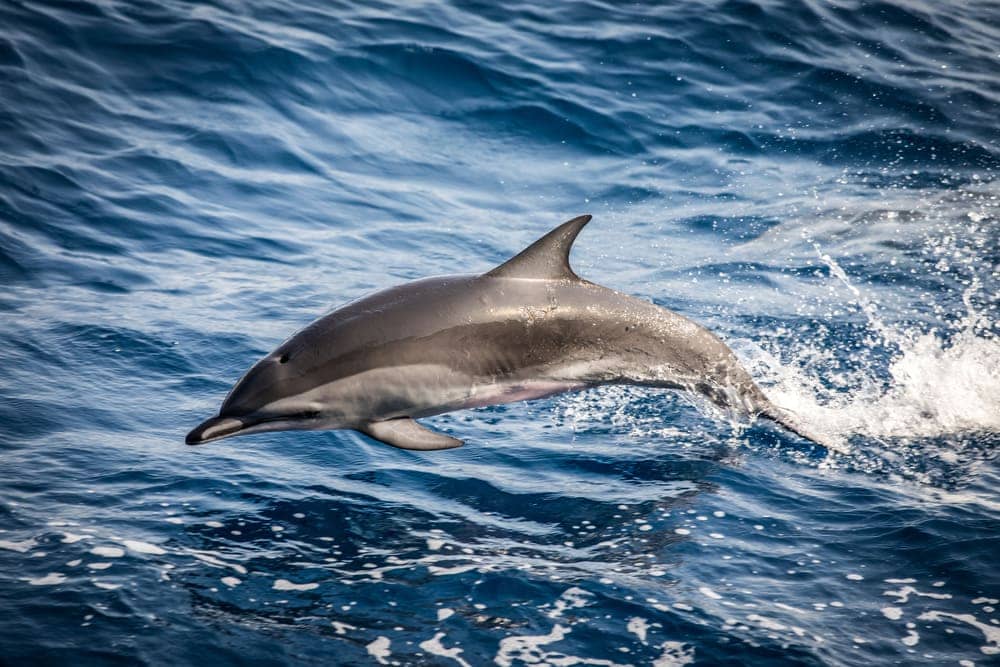
Found only in the Atlantic Ocean, the Clymene dolphin (Stenella clymene) is one of the more unique species on our list. It lives primarily in temperate and tropical waters, but it can sometimes be spotted as far north as Maine.
Interestingly, the Clymene dolphin is actually a hybrid that resulted from the natural hybridization of the striped and the spinner dolphin. So far, it’s the only confirmed case of this kind of natural hybridization among marine mammals.
Clymene dolphins are known for being curious and playful. They frequently approach ships and they are often spotted bow-riding off of the fore of vessels. Additionally, Clymene dolphins are known to travel in groups of up to 150 individuals, though smaller pods are more common.
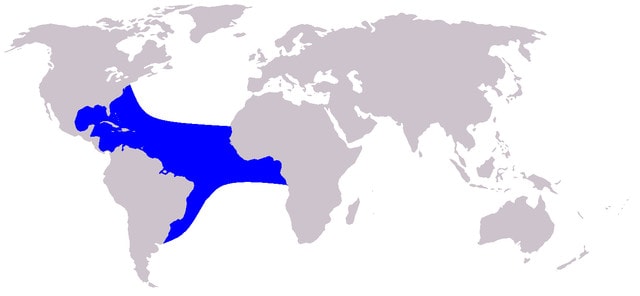
CC BY-S.A 3.0 / pcb21 / wikimedia commons
1.13 False Killer Whale
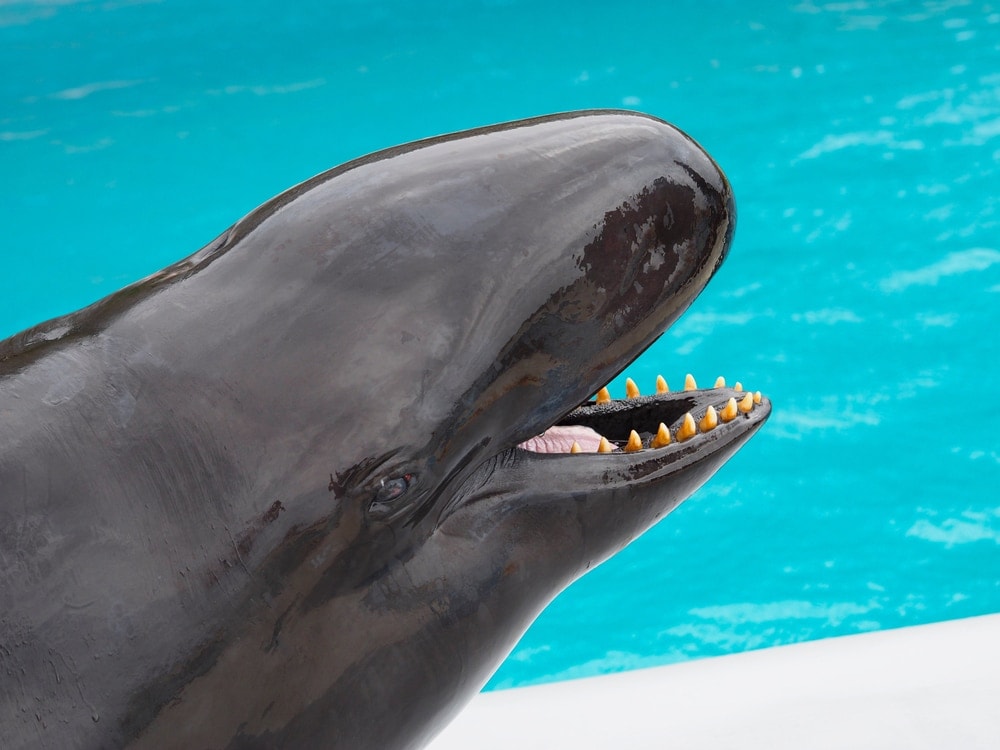
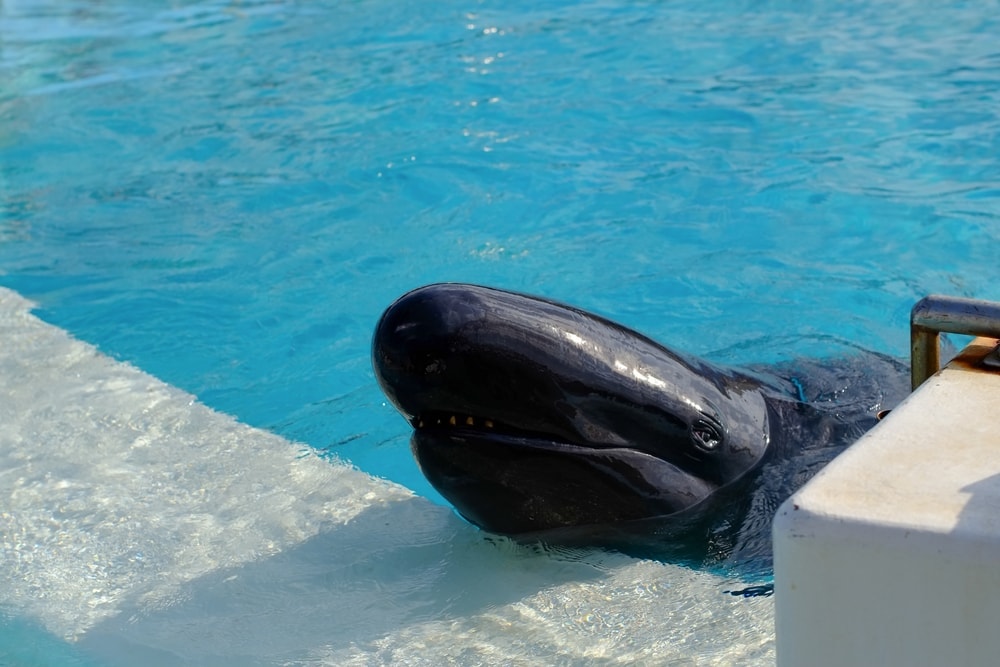
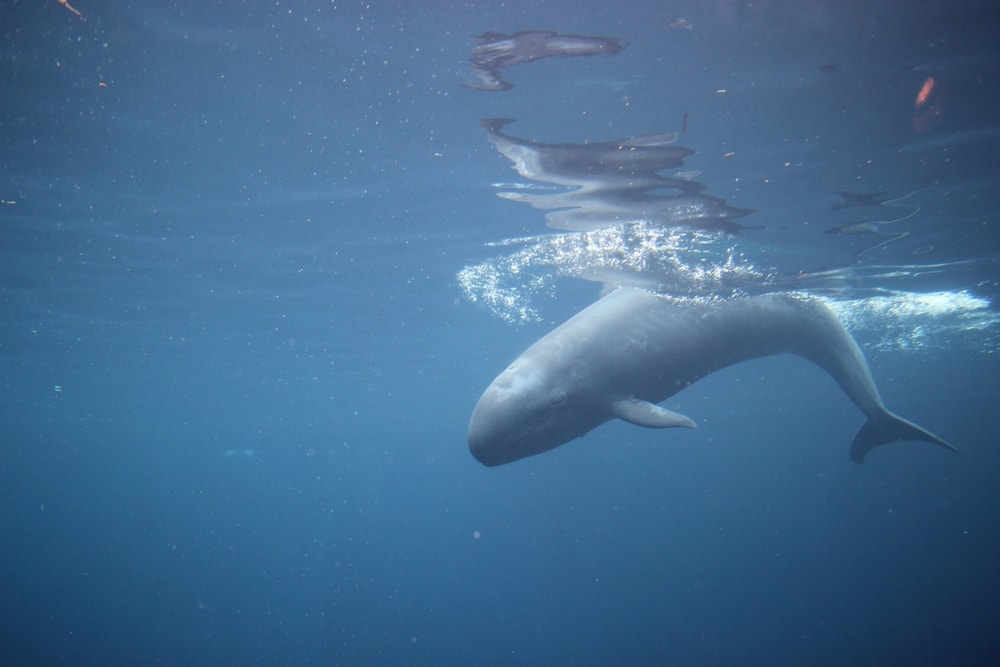
The false killer whale (Pseudorca crassidens) is a relatively large cetacean that can be found in nearly all of the world’s oceans. It prefers to live in tropical and subtropical waters, but it’s often spotted as far north and south as the 50º parallel.
As its name suggests, the false killer whale has some resemblance to the killer whale (orca), but only from a distance. Mistaking the two species for each other up close is difficult because the false killer whale is much smaller and it is almost completely black or dark gray in color without any white spots.
Although the false killer whale has a bad reputation for hunting other dolphin species, it’s also known to have non-aggressive interactions with rough-toothed, Pacific white-sided, and common bottlenose dolphins. Additionally, the false killer whale is very social and it can sometimes form multi-pod groups of more than 500 individuals.
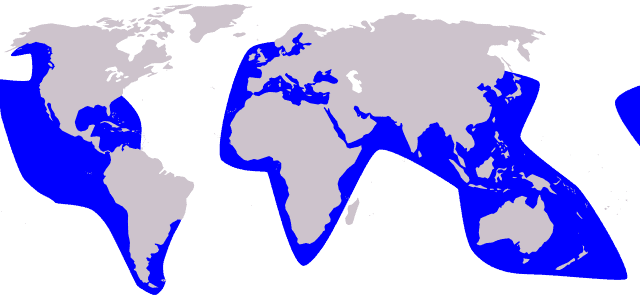
CC BY-S.A 3.0 / pcb21, mononykus, whidou / wikimedia commons
1.14 Striped Dolphin
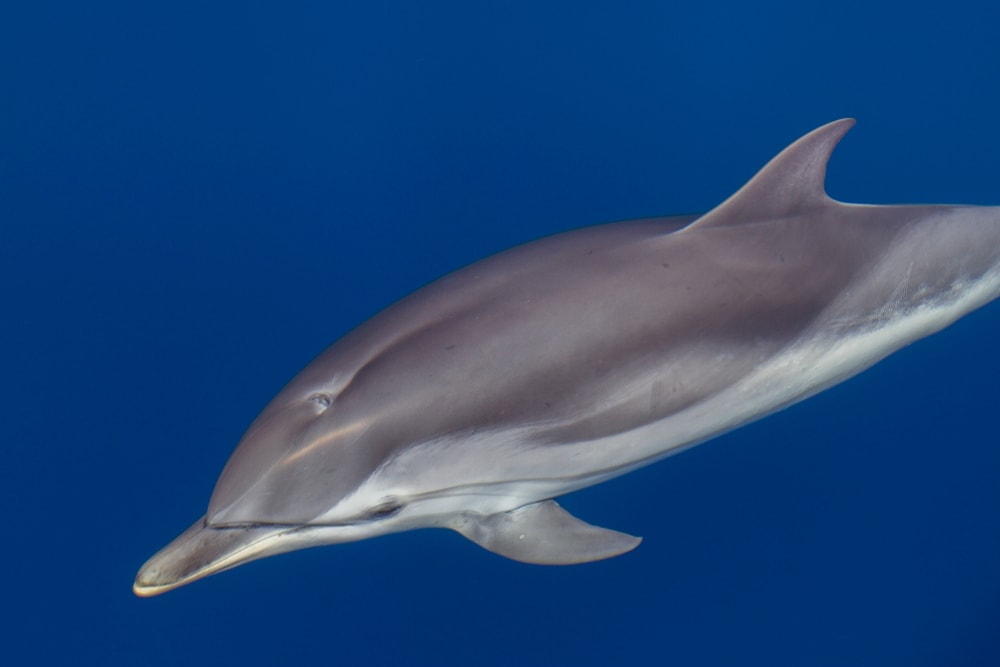
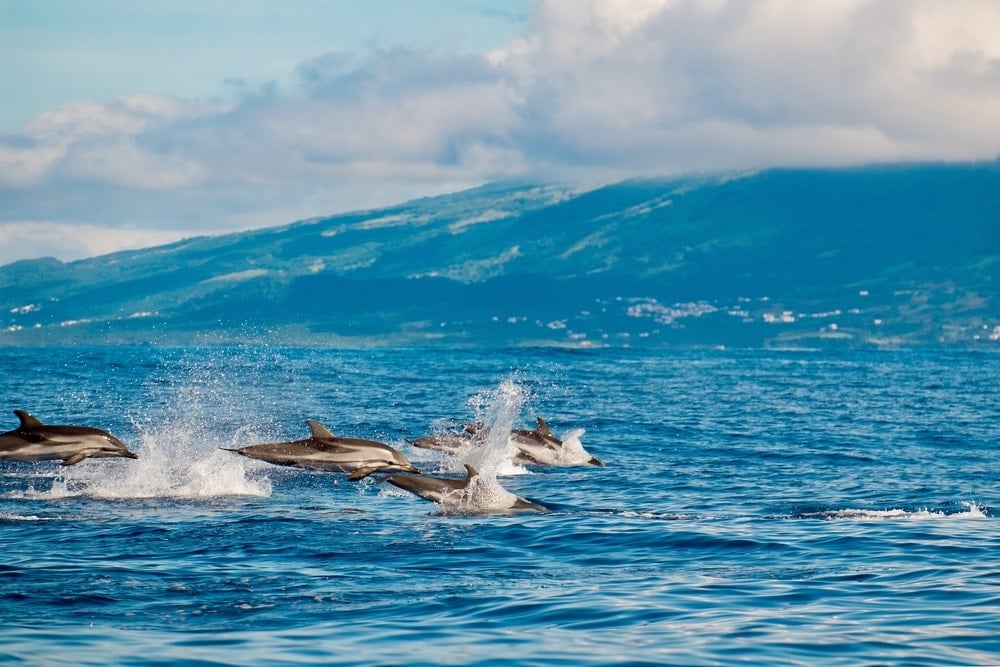
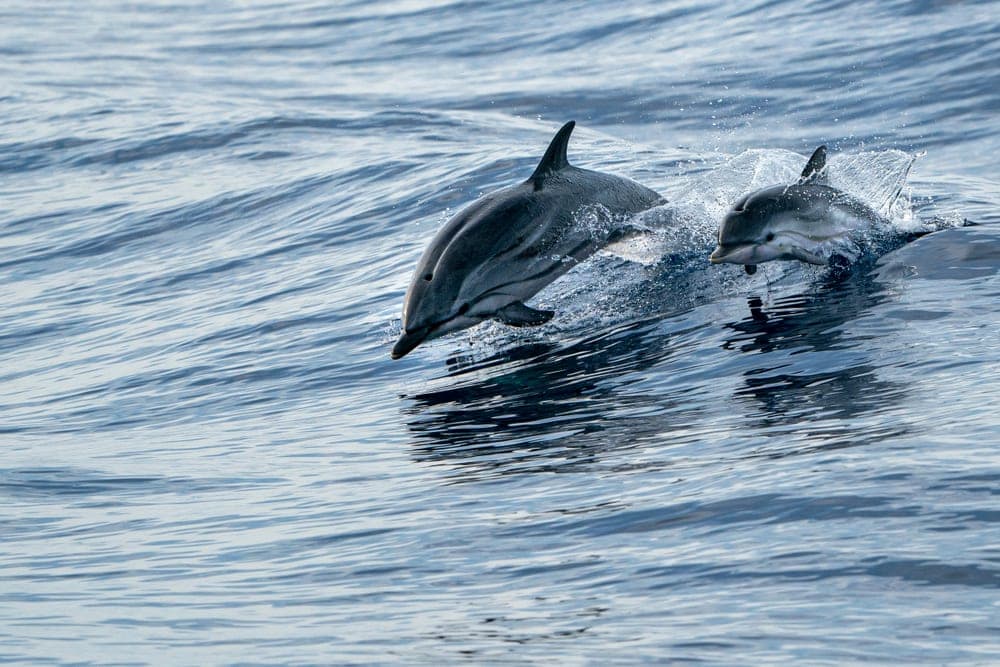
One of the best-studied cetaceans on the planet, the striped dolphin (Stenella coeruleoalba) is a curious marine mammal that lives in tropical and temperate waters around the world. It is particularly common in the Gulf of Mexico and throughout the rest of the Atlantic Ocean.
Even though its range overlaps with that of many other dolphin species, the striped dolphin is fairly easy to identify. It normally has a black to gray-colored back and a blue, pink, or white belly. The striped dolphin’s back and belly are normally separated by two large white stripes (hence the name).
The striped dolphin has long been hunted by humans around the world. However, annual quotas for most legal striped dolphin hunts are quite low and the species is listed as a species of least concern. Its major threats are pollution, entanglement in fishing nets, and collisions with ships.
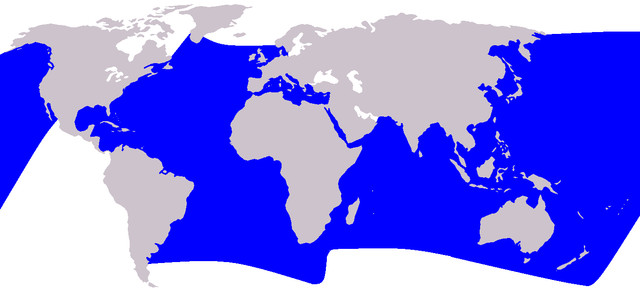
CC BY-S.A 3.0 / pcb21 / wikimedia commons
1.15 Long-Beaked Common Dolphin
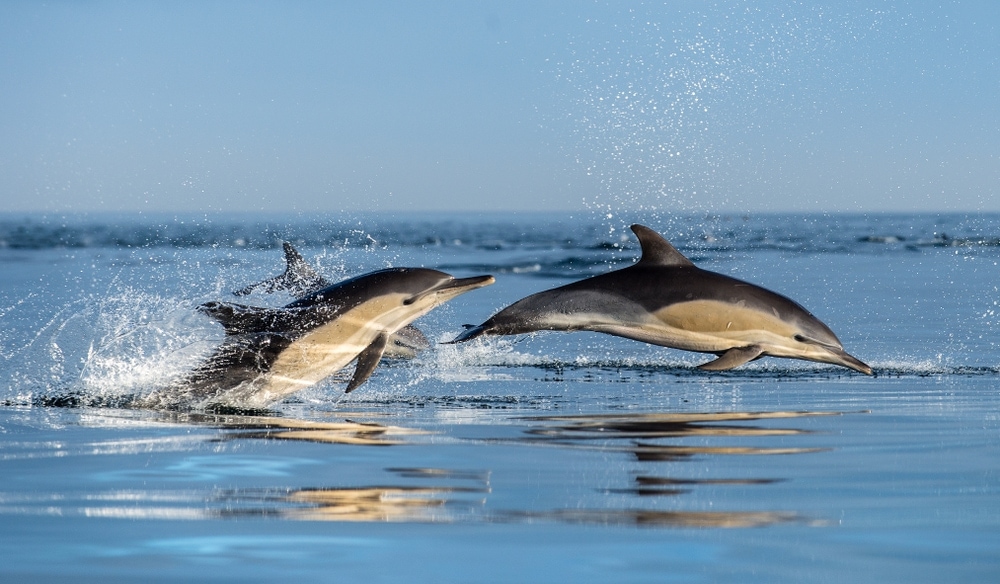
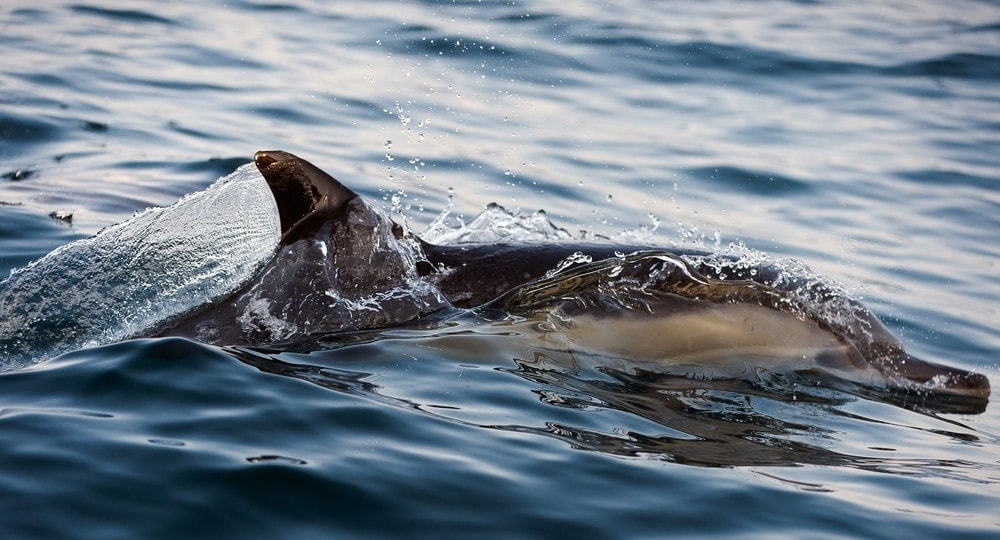
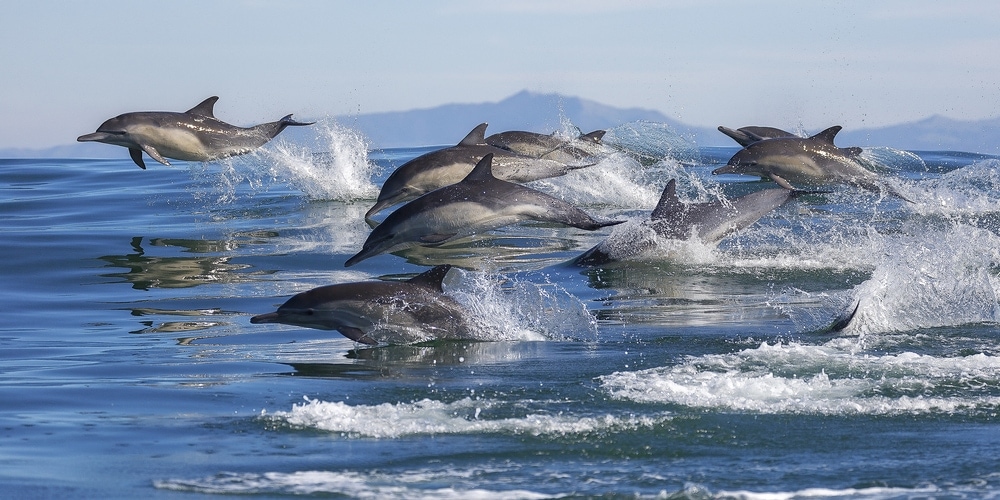
Possibly the most common dolphin species on the planet, the long-beaked common dolphin (Delphinus delphis) is a medium-sized cetacean that usually has a darkly colored back and a lightly colored belly.
These days, the long-beaked common dolphin is often referred to as simply the ‘common dolphin.’ There is a bit of debate among researchers as to whether the long-beaked and the short-beaked common dolphins are actually distinct species. Recent research suggests that they may not be different enough genetically to warrant classification as separate species.
Unlike the common bottlenose dolphin, the long-beaked common dolphin is not commonly kept in captivity. Due to its large population numbers and wide geographic range, the species is listed as being of least concern by the IUCN. However, it is threatened by fishing bycatch, pollution, and disease.
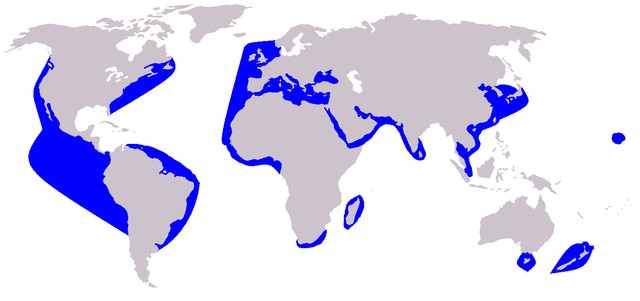
CC BY-S.A 4.0 / geekgecko / wikimedia commons
1.16 Southern Right Whale Dolphin
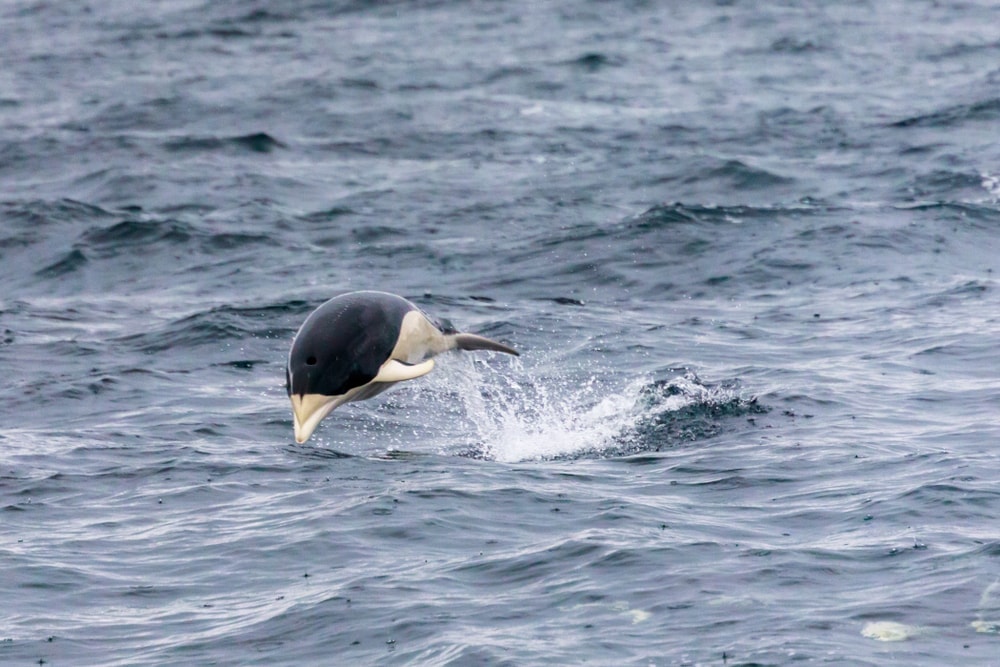
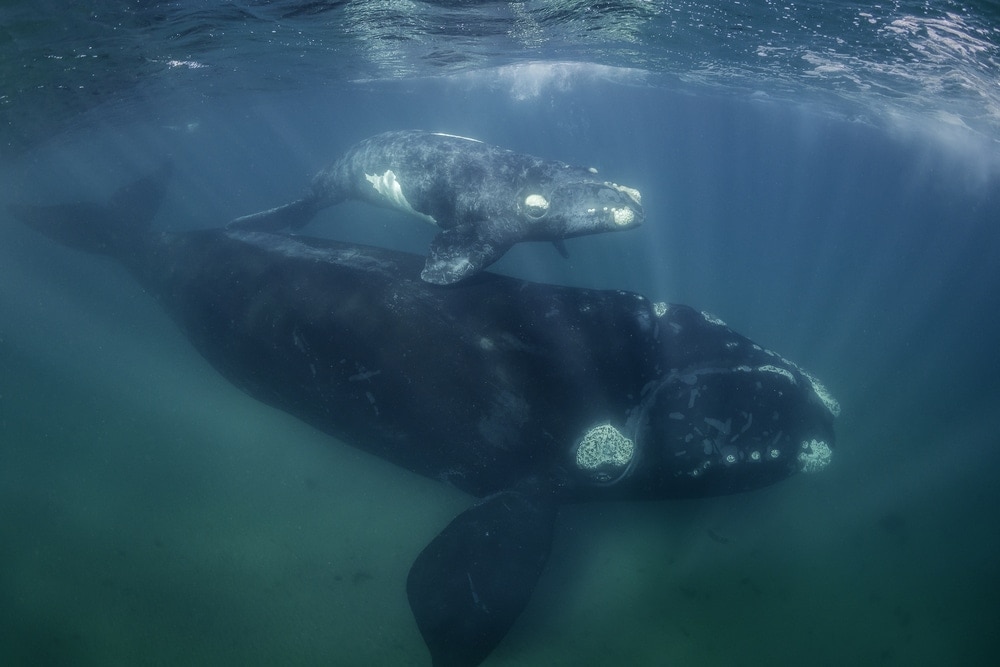
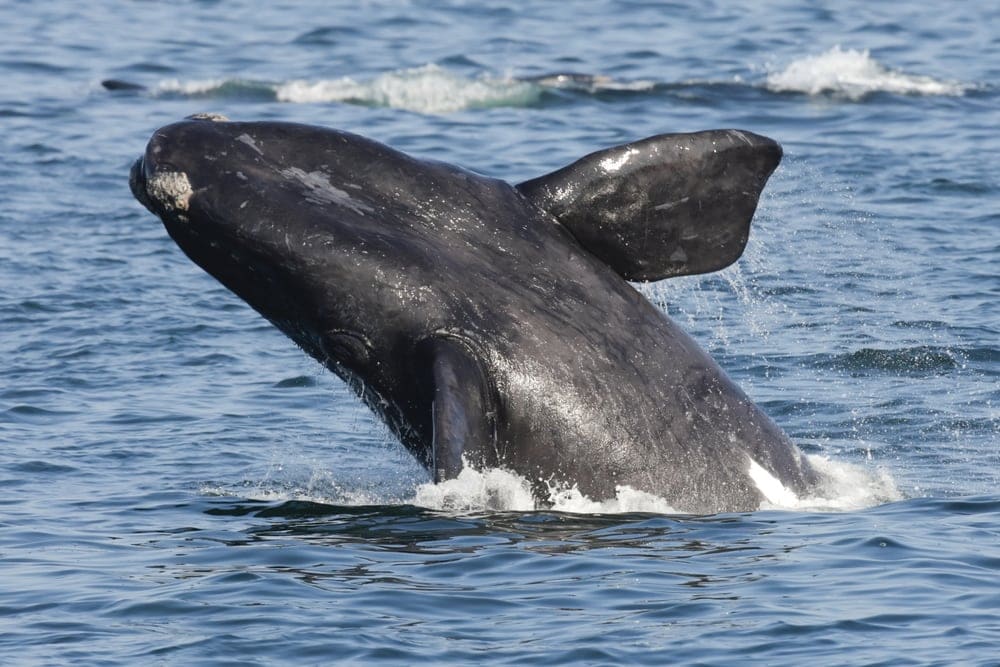
The southern right whale dolphin (Lissodelphis peronii) is a funky-looking cetacean that lives only in colder waters of the Southern Hemisphere. It is closely related to the northern right whale dolphin, which is found only in northerly waters.
Within its range, the southern right whale dolphin is easily identifiable. It’s the only dolphin without a dorsal fin in the entire Southern Hemisphere, and it also has a sleek body with a black back and white belly. The transition between the dolphin’s black back and white belly is also very sharp, giving the species a unique geometric-type patterning.
Relatively little is known about the population trends of the southern right whale dolphin, but it is regarded as a species of least concern. Since it lives in such remote waters, most confirmed sightings of the southern right whale dolphin happen near Cape Horn, southern Africa, and Australia.
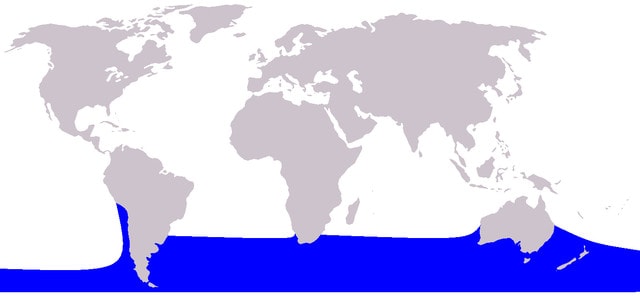
CC BY-S.A 3.0 / pcb21 / wikimedia commons
1.17 Rough-Toothed Dolphin
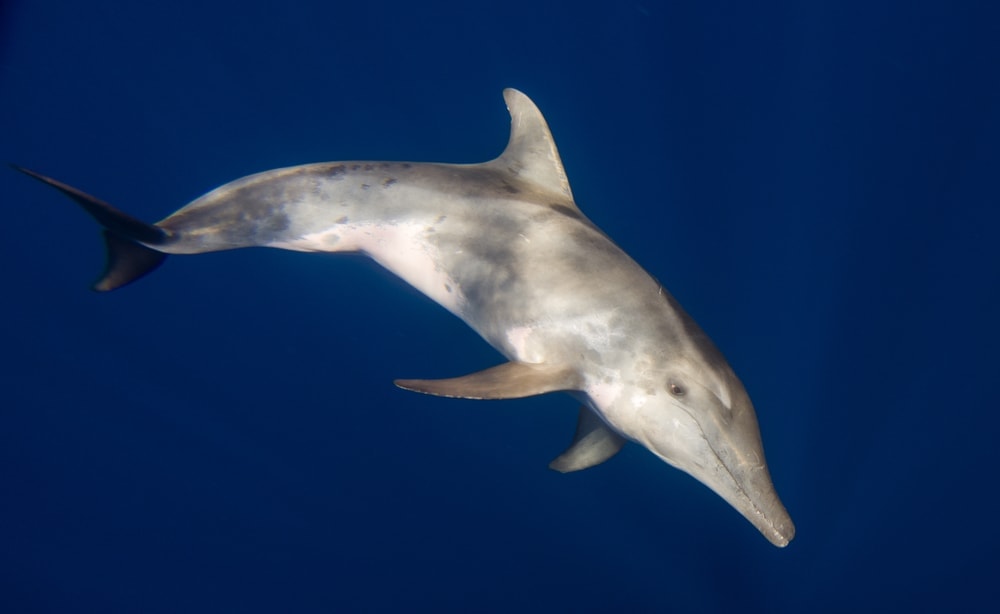

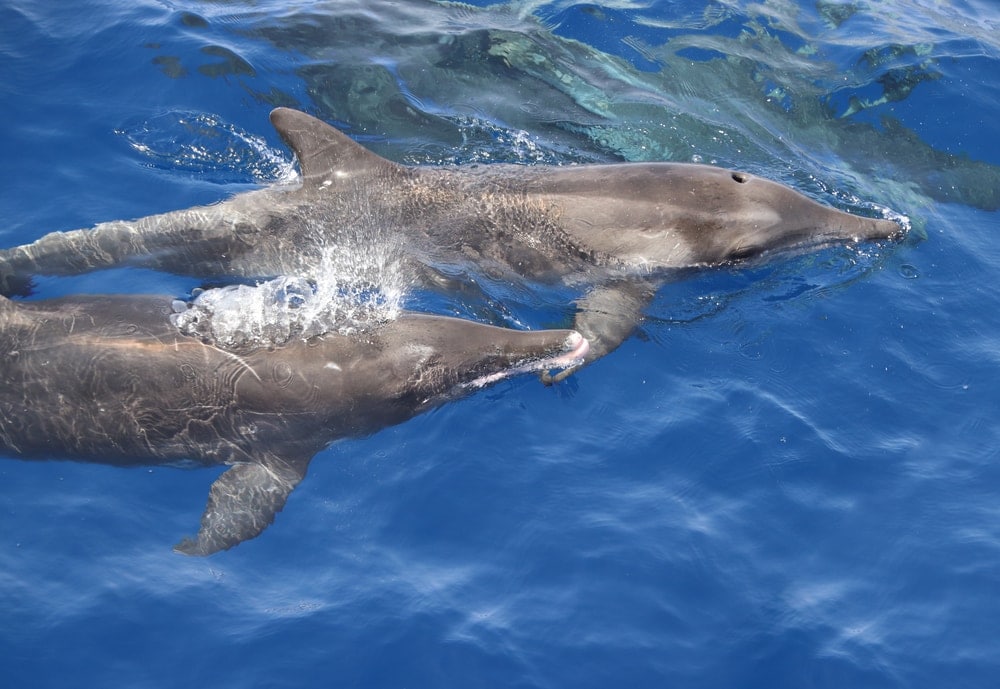
Appropriately named, the rough-toothed dolphin (Steno bredanensis) is a marine mammal that’s found throughout the planet’s temperate and tropical waters. However, the species is very rarely spotted close to shore.
The rough-toothed dolphin gets its name from the fact that its teeth have a distinctive rough surface. Additionally, the lower jaw of the rough-toothed dolphin is often white or pink in color, which stands out against its otherwise gray skin.
Despite the fact that the rough-toothed dolphin is found in most of the world’s oceans, it’s not well-studied. Researchers have classified it as a species of least concern. But, the species’ major threat is getting trapped as bycatch by fishing nets.
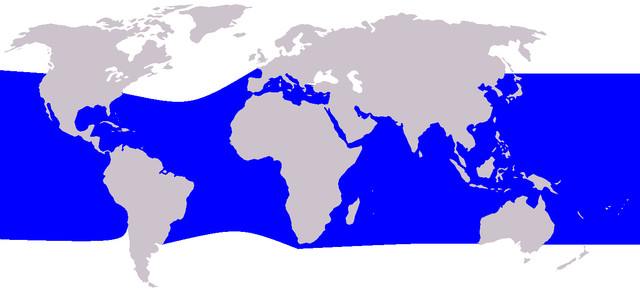
CC BY-S.A 3.0 / pcb21 / wikimedia commons
1.18 Electra Dolphin
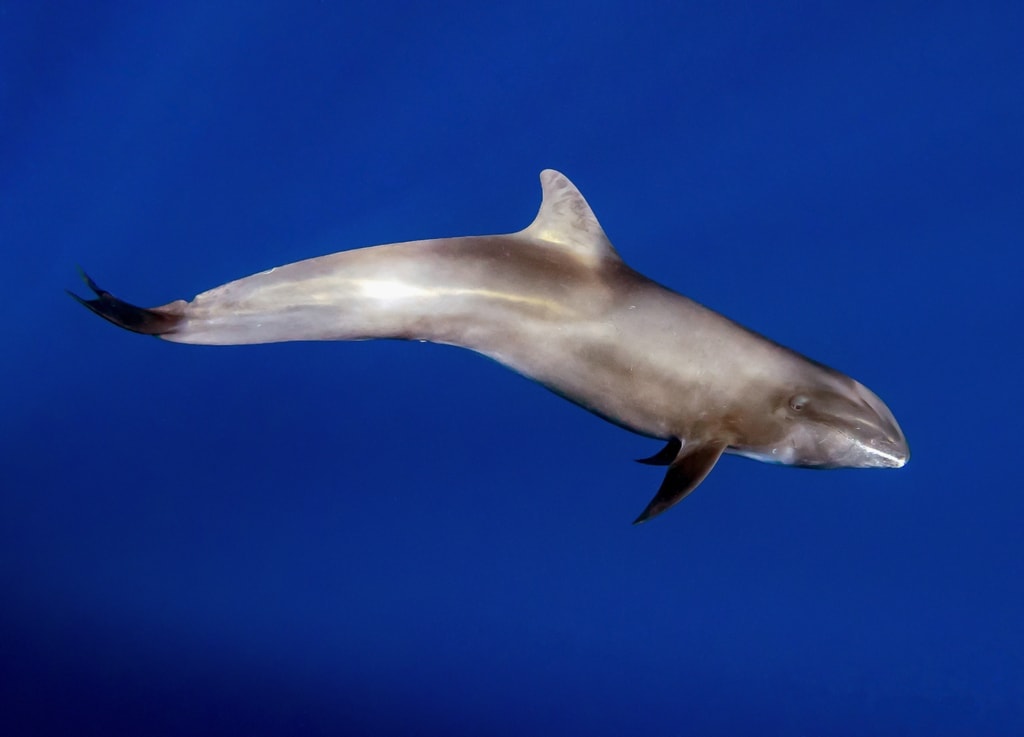
CC BY-S.A / Cyril di Bisceglie / inaturalist.org
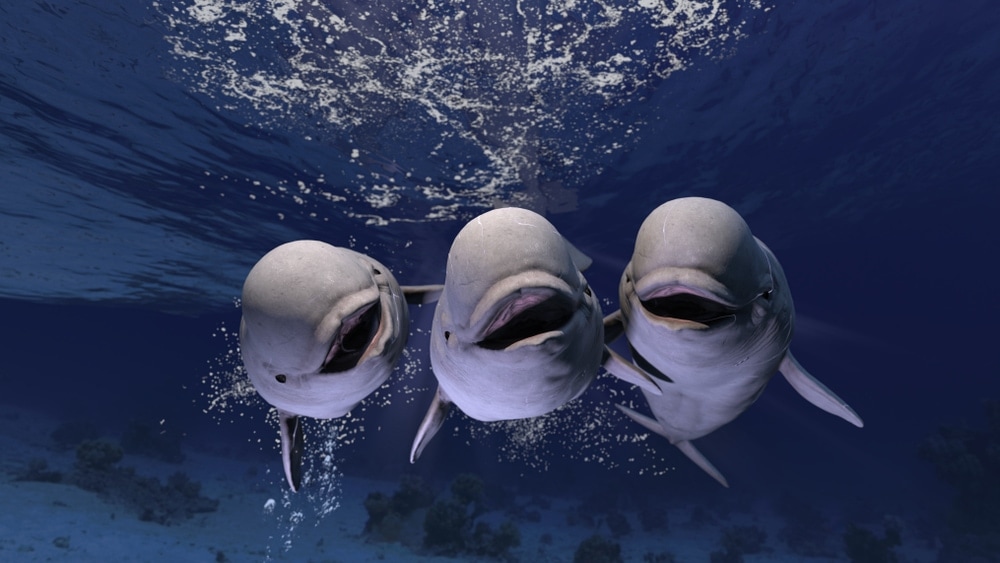
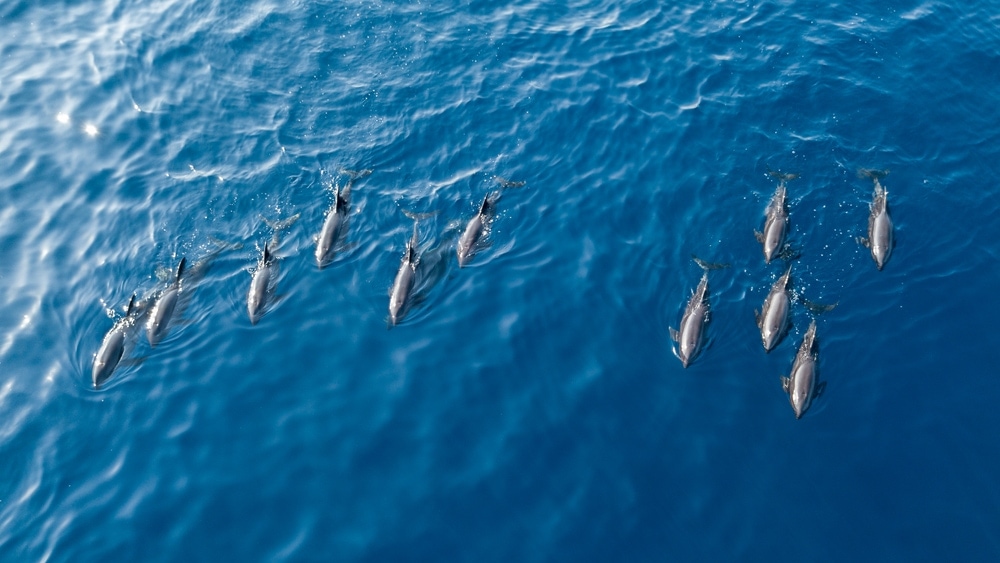
Also known as the melon-headed whale, the electra dolphin (Peponocephala electra) is one of the more visibly unique cetaceans on our list. It lives throughout subtropical and tropical waters, though there are a number of distinct populations of the electra dolphin around Hawaii and the Philippines.
As some of its common names suggest, the electra dolphin has a melon-shaped head. It has a large, round head with no beak and a dark gray or black body. However, it has a very prominent sickle-shaped dorsal fin that makes it easy to distinguish from false killer whales.
Relatively little is known about the electra dolphin except that it likes to swim very quickly in very large, tightly clustered pods. It is a species of least concern, however, the electra dolphin is commonly hunted and it appears to be very vulnerable to both human-produced noise and chemical pollution.
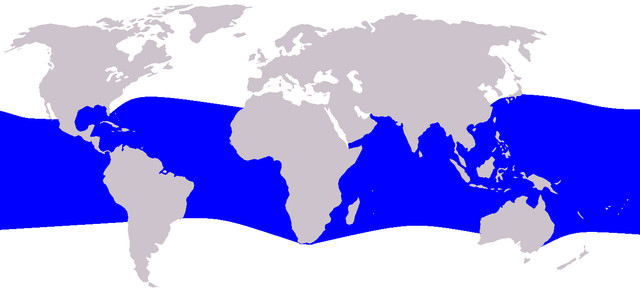
CC BY-S.A 3.0 / pcb21 / wikimedia commons
1.19 Indo-Pacific Humpback Dolphin
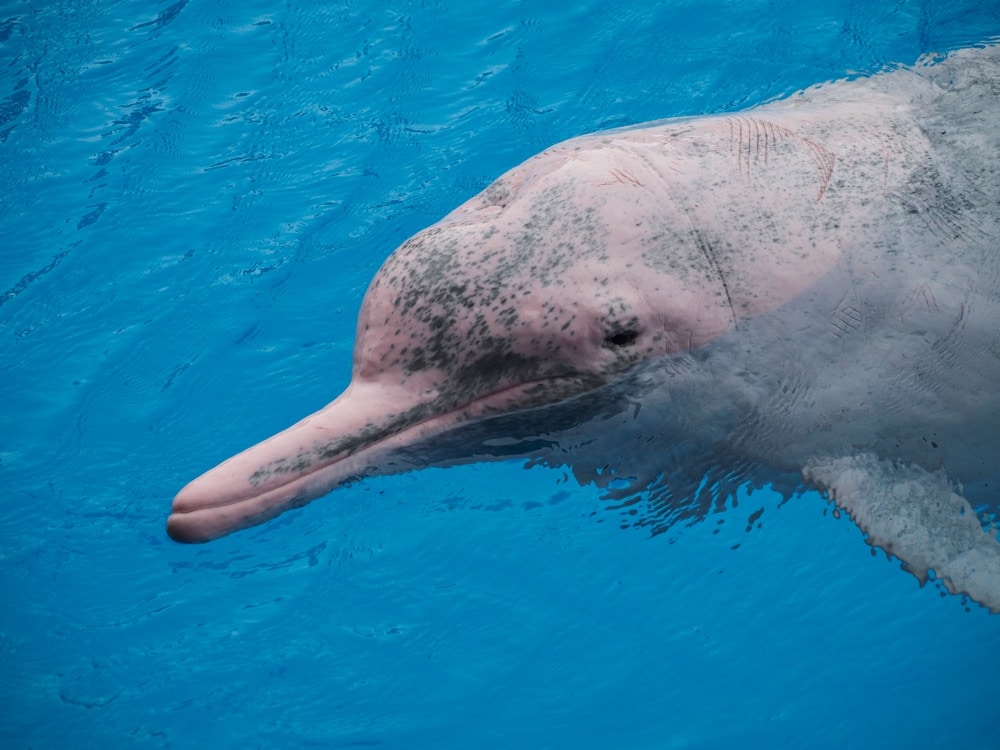

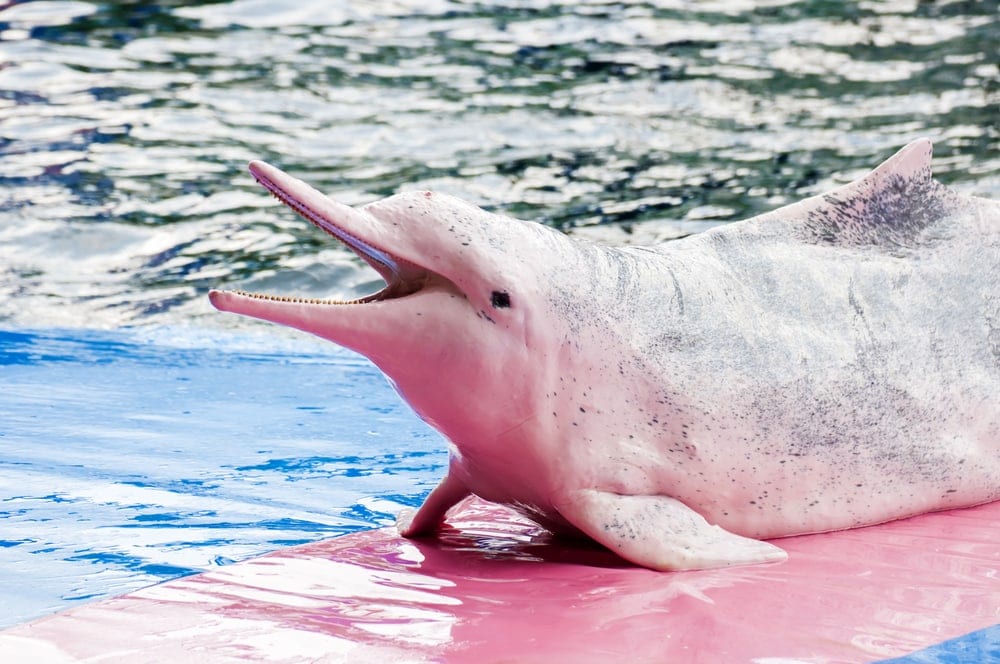
Sometimes called the Chinese white dolphin, the Indo-Pacific humpback dolphin (Sousa chinensis) is a mid-sized marine mammal that lives only in the waters of southeastern Asia. However, it is not to be confused with the baiji (Lipotes vexillifer), which is a species of river dolphin in China that may be extinct.
Indo-Pacific humpback dolphins can have a wide range of color patterns. They can range from white and grey to pink in color; however, most calves are born as either black or dark gray.
Interestingly, the Indo-Pacific humpback dolphin is one of the few oceanic dolphins that’s listed as vulnerable by the IUCN. The species appears to be easily disturbed by humans and it is often trapped in fishing nets. Pollution and vessel collisions are also major threats to the species’ long-term well-being.
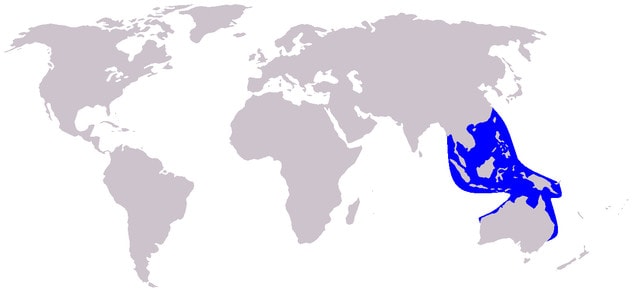
CC BY-S.A 3.0 / pcb21 / wikimedia commons
2. River Dolphins
Most of the world’s dolphin species live in oceans; however, there are a handful of dolphins that live exclusively in rivers. These dolphins inhabit some of the world’s largest rivers, such as the Amazon, Ganges, and Indus rivers, but they are also among the most highly threatened cetaceans on the planet. This is what you need to know.
2.1 Amazon River Dolphin
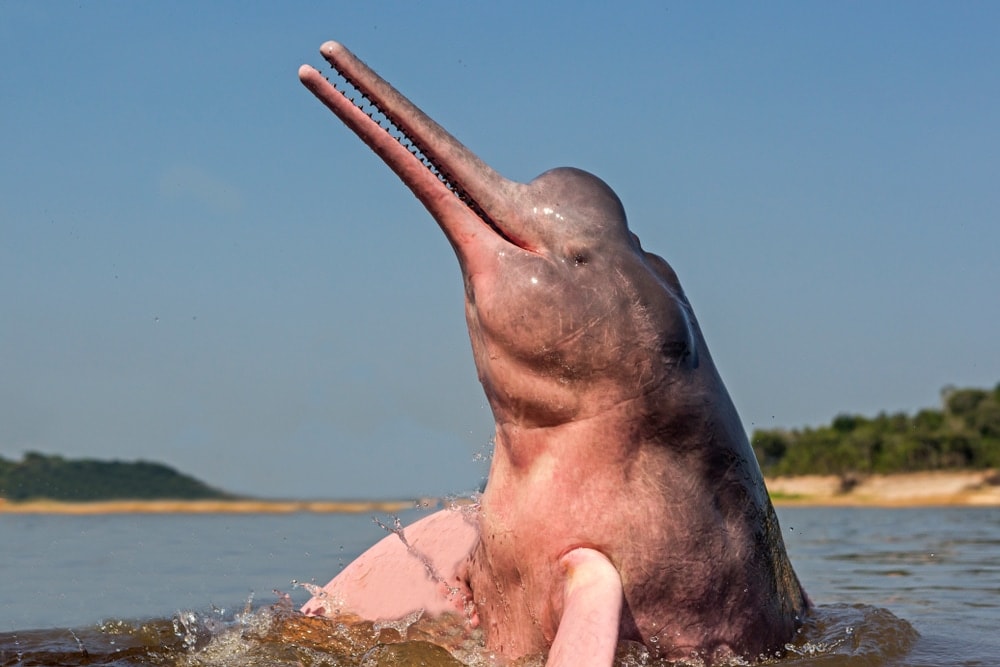
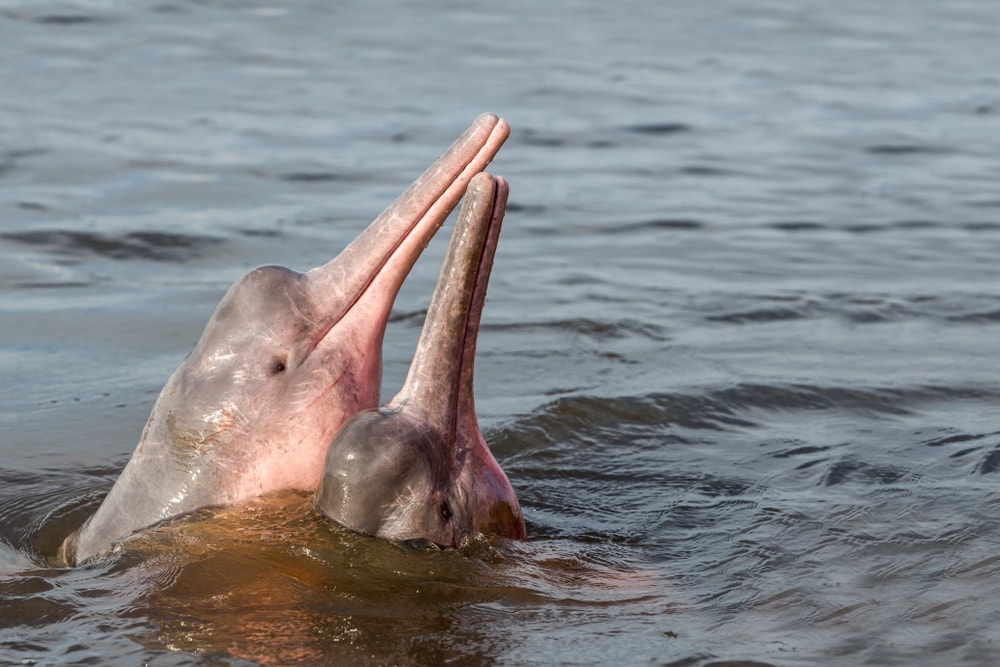
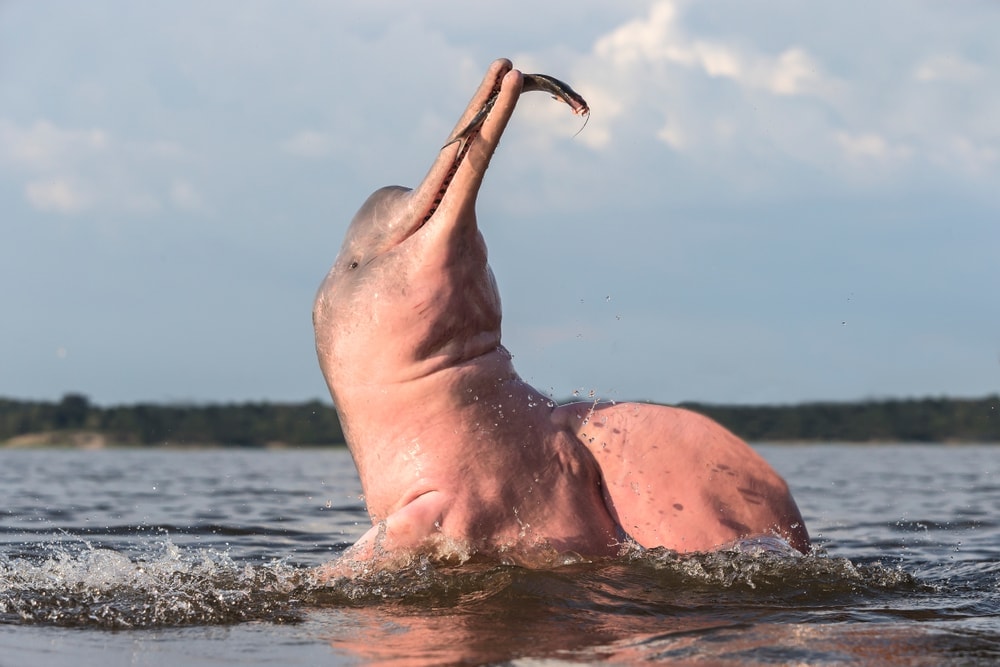
Commonly known as the boto or bufeo, the Amazon river dolphin (Inia geoffrensis) is a large cetacean that lives only in the Amazon River Basin. It is actually the largest of the world’s river dolphins as it can weigh upwards of 400 lbs (185 kg) when fully grown.
Additionally, the Amazon river dolphin appears to have one of the largest dietary ranges of any dolphin. It is known to eat dozens of fish species, including piranhas. These dolphins also commonly eat crabs species and river turtles.
The IUCN currently lists the Amazon river dolphin as endangered, but it was considered to be data deficient for a long time due to the remoteness of its range. Its primary threats are human development, oil and gas drilling, pollution, and human disturbance.
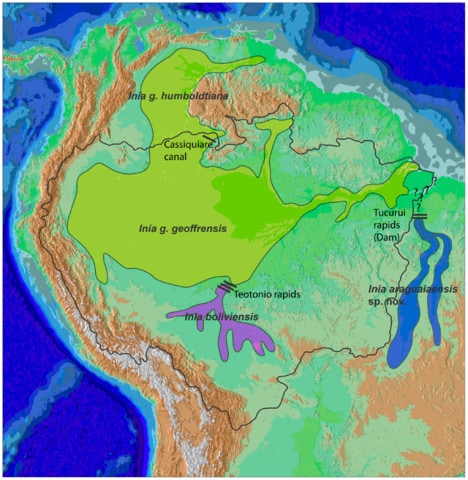
CC BY-S.A 3.0 / pcb21 / wikimedia commons
2.2 Araguaian River Dolphin
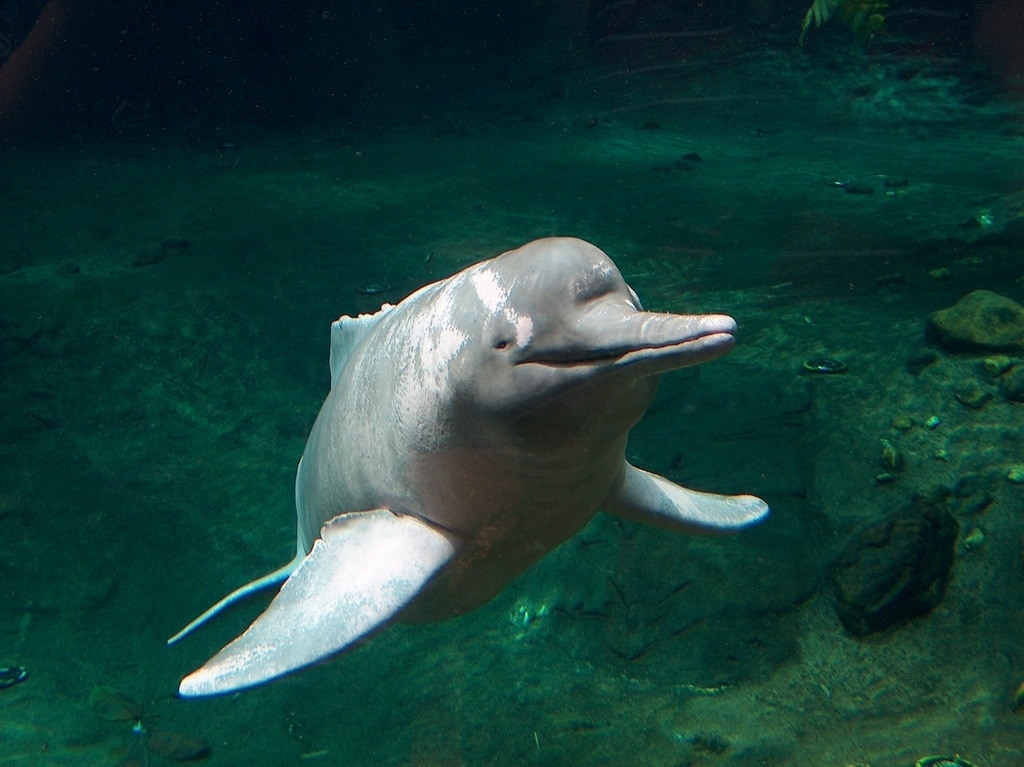
CC by-sa / Oceancetaceen / inaturalist.org
The Araguaian river dolphin (Inia araguaiaensis) is a poorly studied marine mammal that lives in the Araguaia–Tocantins River Basin of Brazil. There is still some debate as to whether the Araguaian river dolphin is a separate species from the Amazon river dolphin, but DNA evidence from 2014 suggests that they are distinct species.
Similar to many other river dolphins, the Araguaian river dolphin has a very prominent forehead and a long snout. It also has unfused vertebrae in its neck, giving it the ability to turn its head sharply to either side.
Since there is some disagreement as to whether the Araguaian river dolphin is its own species, it isn’t currently listed by the IUCN. However, researchers believe that there are only about 1,500 individuals left in the wild, so a lack of genetic diversity and habitat fragmentation are likely to be the species’ biggest threats.
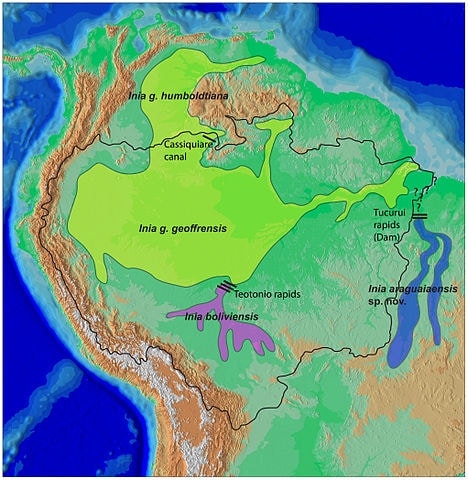
CC BY 2.5 / T.Hrbek, V. da Silva, N. Dutra, W. Gravena, A. R. Martin, I.P. Farias/ wikimedia commons
2.3 Bolivian River Dolphin
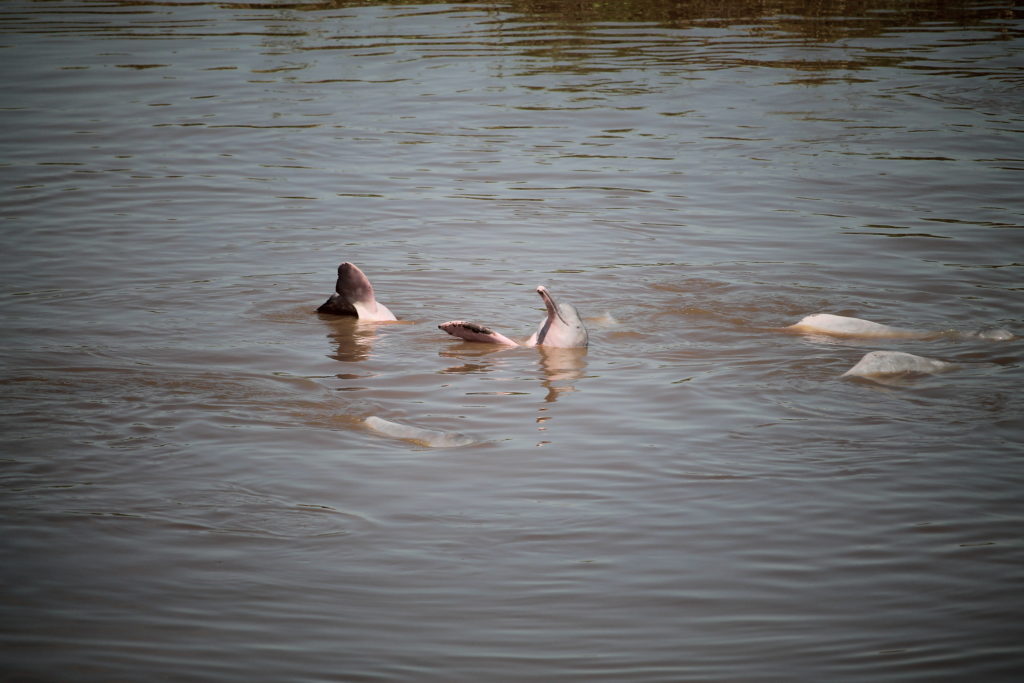
CC BY-SA / Ramon and Suzanne Vargas / inatularist.org
The Bolivian river dolphin (Inia boliviensis) is another freshwater cetacean that’s closely related to the Amazon river dolphin. There’s also some debate as to whether the Bolivian dolphin is genetically distinct enough to warrant becoming its own species, so it’s not listed by the IUCN.
This dolphin is found primarily in the Upper Madeira Basin of the Amazon in Bolivia. It is separated from the main Amazon river dolphin population by a series of large rapids, so it’s likely that the two populations have been distinct for quite some time.
Although more research is needed to understand the health of the Bolivian river dolphin’s populations, it’s already protected under Bolivian law. In fact, President Evo Morales signed a law into place in 2012 that classified the species as a national treasure.
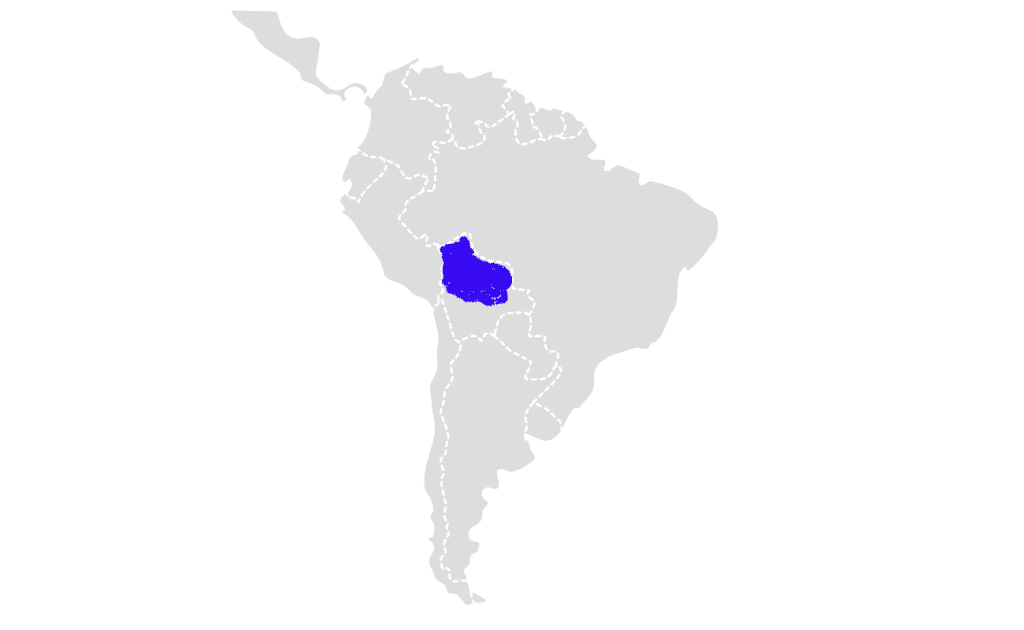
2.4 Ganges River Dolphin
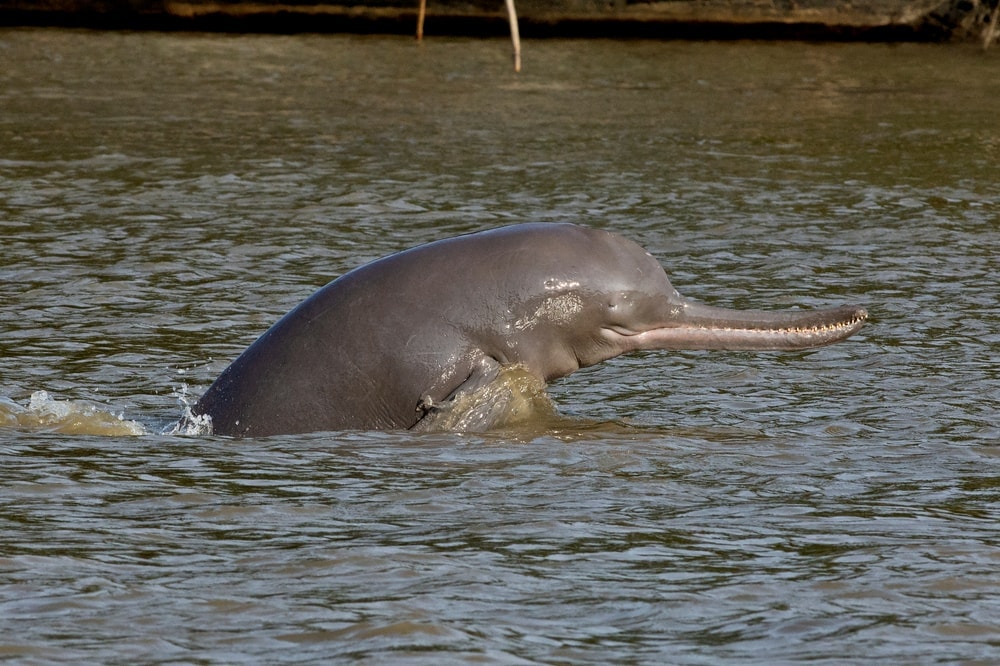
As its name suggests, the Ganges river dolphin (Platanista gangetica) is a type of cetacean that lives in the Ganges River and its tributaries. It’s primarily found in India, Bangladesh, and Nepal where it is known as the susu or the shushuk.
Although they are closely related, the Ganges river dolphin and the Indus river dolphin are separate species. They are believed to have diverged evolutionarily about 550,000 years ago, though they still share similar physical characteristics.
The Ganges river dolphin is listed as an endangered species and there may be as few as 3,000 individuals left in the wild. Pollution, which is a well-known issue on the Ganges, is one of the species’ biggest threats. However, the species is protected by law in India, so it is illegal to keep one in captivity except for certain scientific or rehabilitation purposes.

2.5 Indus River Dolphin
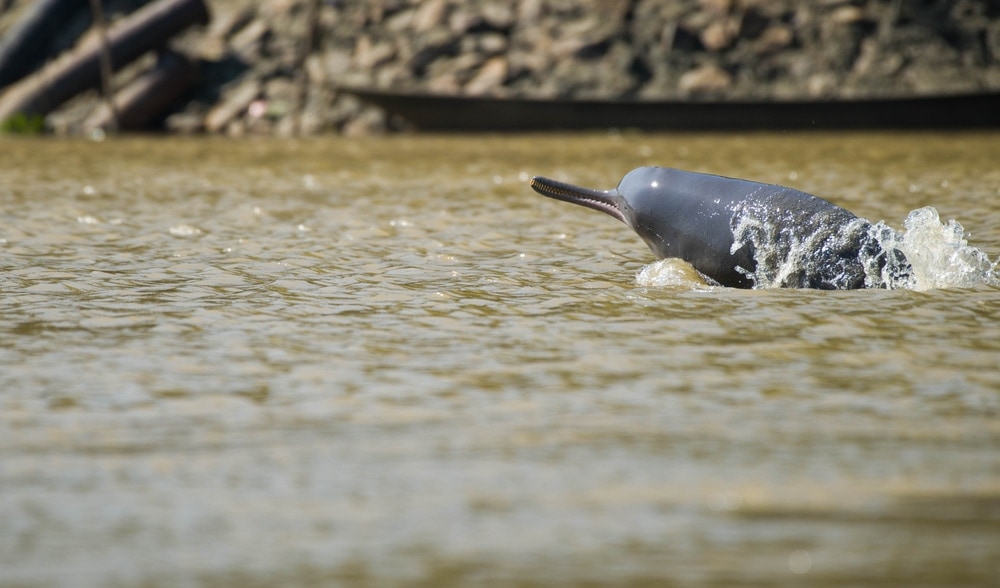
Commonly known as bhulan, the Indus river dolphin (Platanista minor) is the second of two river dolphin species in south-central Asia. It lives only in the Indus River Basin and its range is primarily restricted to Pakistan and a small area of India.
Due to human development, the Indus river dolphin’s global population is currently split into five smaller populations that are separated by irrigation dams and barrages. It is an IUCN-listed endangered species and it is often considered to be one of the world’s most endangered cetaceans.
One of the biggest threats to the species’ survival is human development, however, overfishing of its food source is also an issue. The Indus river dolphin isn’t well-studied, so more research is needed to better understand how to conserve this species.

2.6 Tucuxi
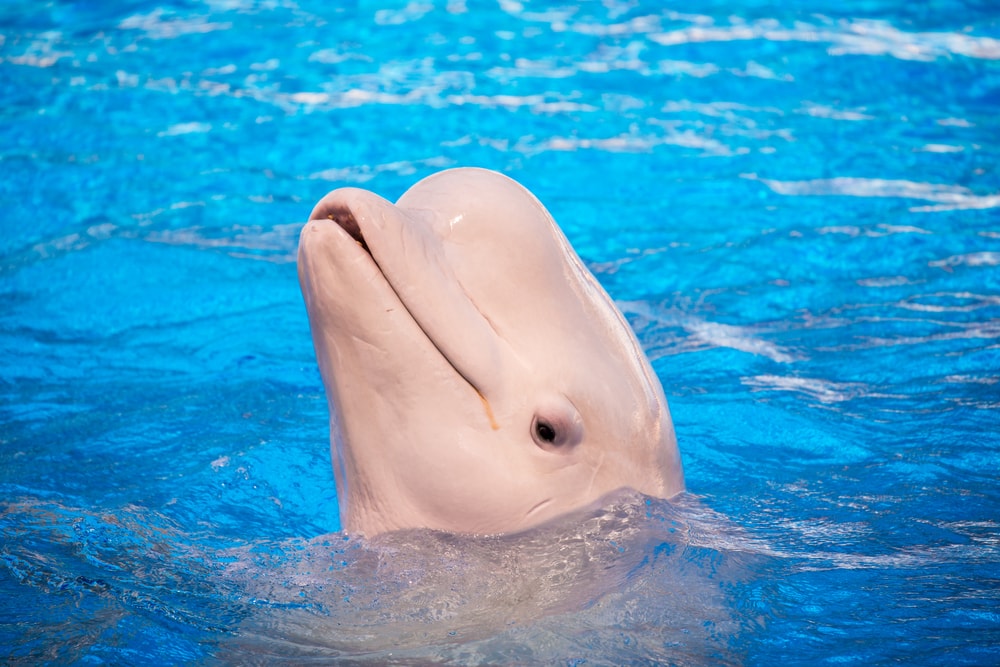
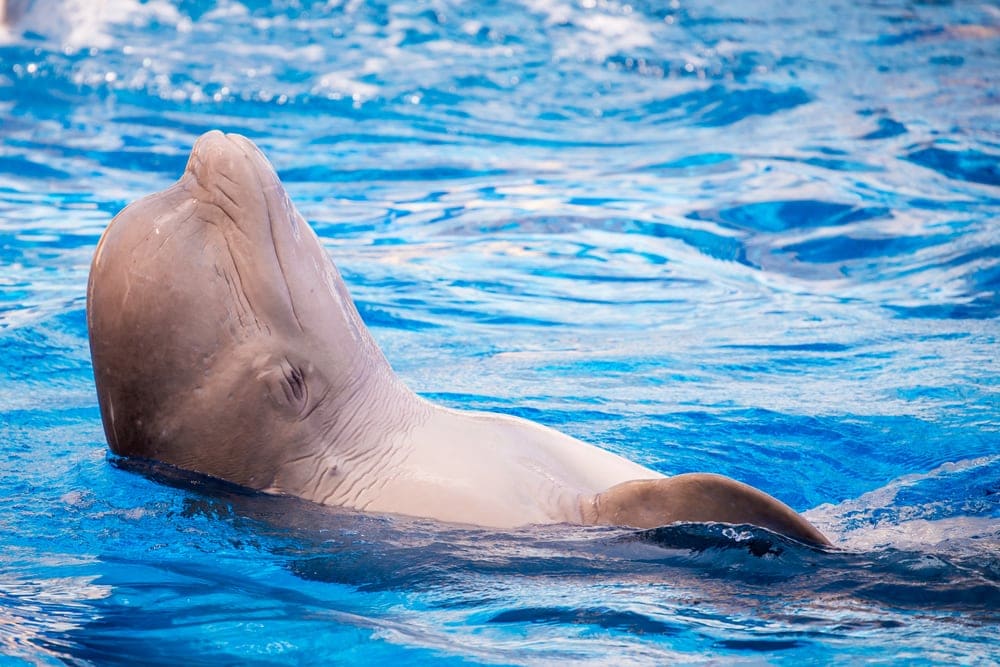
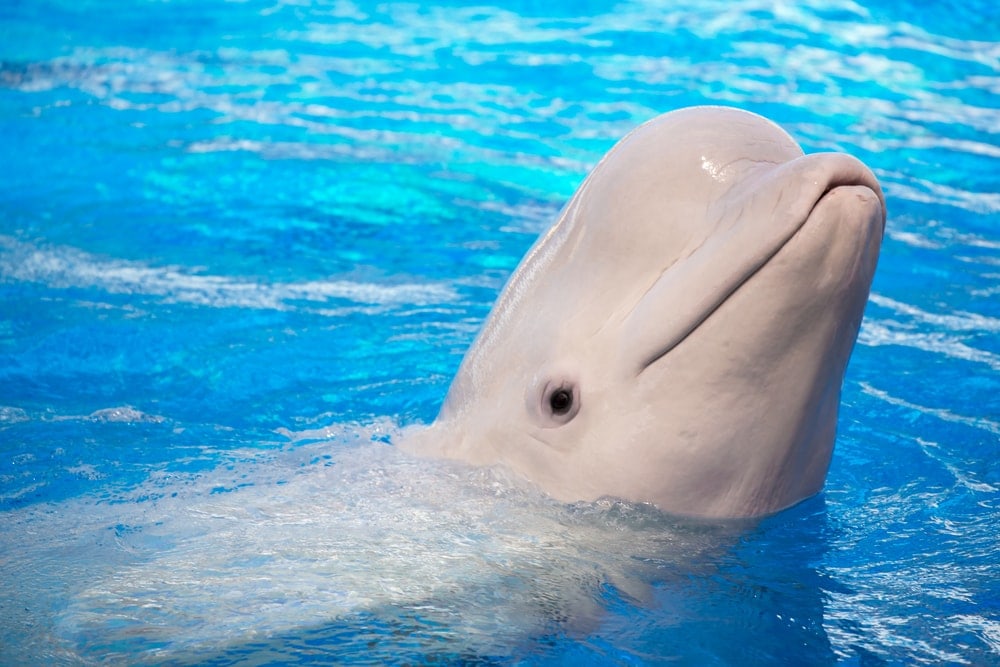
Finally, we have the tucuxi (Sotalia fluviatilis), which is a small freshwater dolphin that lives in the Amazon River Basin. It is unique among the river dolphins because its facial structure much more closely resembles that of a bottlenose dolphin.
There is some debate among scientists as to when the tucuxi split off from its closest relative, the Guiana dolphin. The Guiana dolphin, or costero, as it’s better known, is able to live in both fresh and saltwater environments and its range often overlaps with that of the tucuxi.
But unlike the costero, the tucuxi is listed as an endangered species primarily as a result of human development. The construction of dams throughout its range and the increase in pollution in recent years are major threats to the species’ survival.
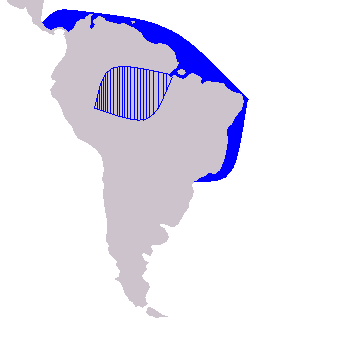
CC BY-S.A 3.0 / pcb21 / wikimedia commons










